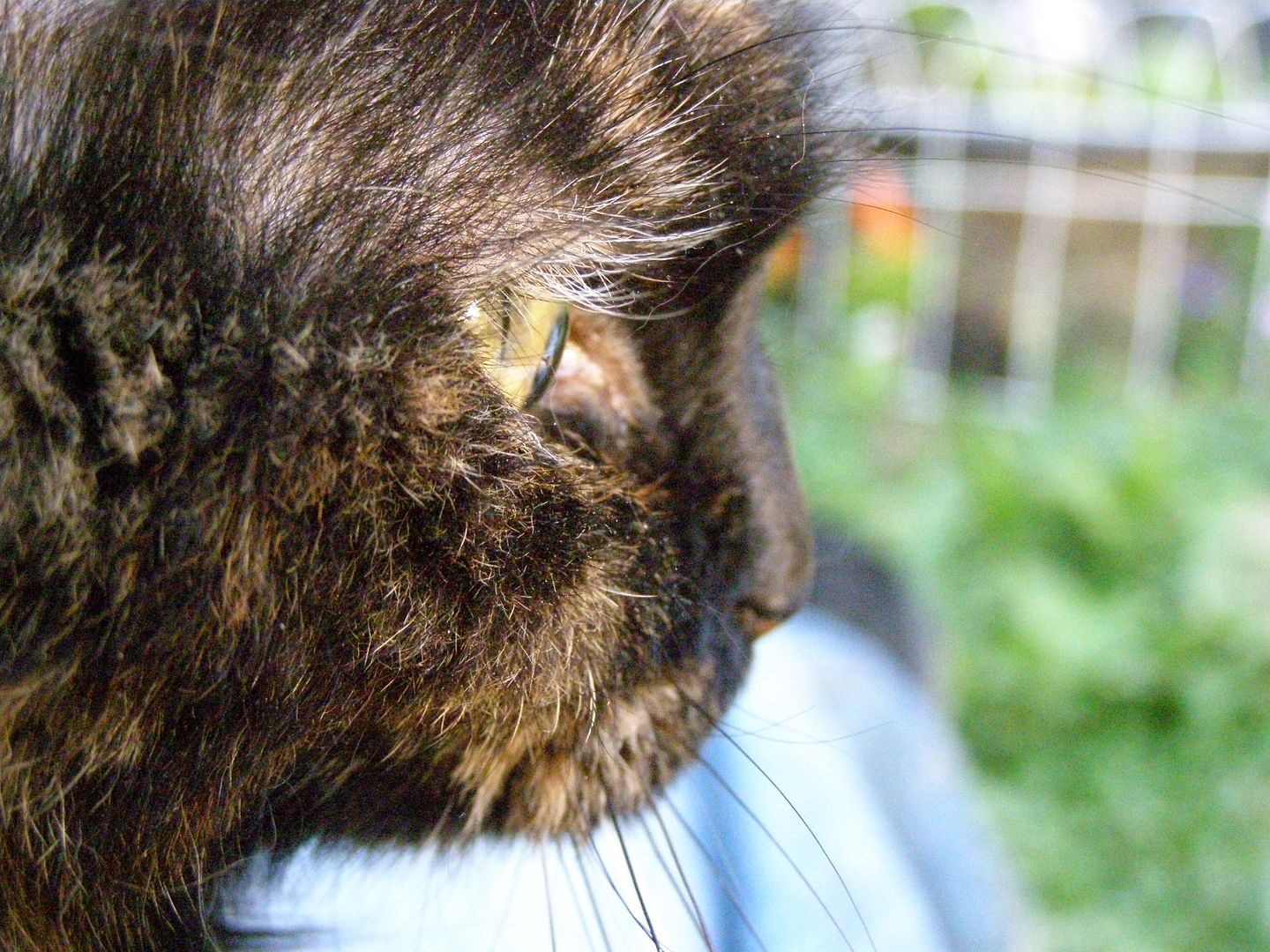Monday, November 30, 2009
The Onion: Zombie Reagan Raised From the Grave to Lead GOP
Zombie Reagan Raised From Grave To Lead GOP
I love what's said after the main story here. "The EPA announced they have lost the endangered species list."
Friday, November 27, 2009
Aquaponics vs Hydroponics
Over the summer we didn't get a single tomato from our garden thanks to me picking some crazy heirloom varieties that do awful in our climate. To say sorry to my dad I bought an AeroGarden kit. They're a little expensive. We bought one for 6 plants at a time, the link above is a smaller model for 3 plants. I'm promoting the smaller model because a lot of people seem to be complaining about these. It's the kind of product that will probably break if shaken around to much so maybe buying at the store is the better way to go. Anyhow.
We're currently growing 3 tomato plants and they actually are producing tomatoes. My only complain is that tomato plants normally grow to be a 25 foot tall vine in the right conditions and the wonderful power of Hydroponics make them grow a little to well. Instructions suggest pruning the plants back and we'll have to do just that. They've already fallen over away from the light and are spreading on the kitchen counter. Parts to far away from the light are dying naturally though. Despite being a wind pollinator they're still producing tomatoes. We've yet to harvest one but we have a few little green tomatoes on each plant.
Smaller herb plants are probably more ideal for this on the counter setup. It's a shame we can't grow both at the same time. We tried to grow chives with the tomatoes and they got to much fertilizer and died out. The setup needs to be set to what kind of plant you're growing you see in order to time when to add more minerals into the water. I really like this product and think it's a wonderful addition to anyone's home. I've actually asked myself why garden centers don't sell herbs in planters at this time of year for indoor use, and so far I've yet to find an answer.
Can this system be improved?
Aquaponics is almost the same system but the water is circulated between a fish tank and a Hydroponic system. The other product above (here) looks like a fantastic system. The idea here is rather then constantly putting in pills of minerals (which is only ever done maybe twice a month anyhow) you have the fish waste fertilize the plants. Before getting all excited and buying this thing I'd like to point out the fine print.
Rocks, fish, fish food, plants or seeds and GLASS TANK are supplied by customer.So $239 buys you all the pumps and times needed. You're also getting the stand and basically a raised waterproof flower bed. All of these things sound simple enough to buy and design with parts at your local hardware store. The only thing I'd worry about is weather or not the lining for the flower bed was of food grade. If you've got the money though I guess it's a time saver. And if you really got the money here's a top of the line model for $3,000.
But the real question is Do these products really work? For that I turn to YouTube. While I couldn't find anyone using the smaller model, I was able to find someone using a very similar looking top of the line model.
Now a lot of what these people are growing seriously require pollination, so bees are a must. Otherwise you'll be out there with a clean paint brush doing some pollinating of your own. (Sometimes stuffing male flowers into female flowers will work too.) But notice they're using Telapia, which I'm told taste great, as the fish. You could also use a $1's of feeder Gold Fish (usually 10), per tank. An Algae Eater could possibly keep the tank clean.
Going back to the smaller model, we used to have a fish tank. A lot of homes do. With just a few pumps, a timer, and a waterproof flowerbed any freshwater tank could be converted into an Aquaponic system. So you're basically turning the simple task of feeding the fish each morning and letting that grow plants. How's that for a mind blowing glimpse into the ecosystem?
This December I think I'll cave in and buy the smaller Aquaponics setup from Amazon. I'll post back how my experience went. They take a few weeks to setup I think, need to let the fish swim around for two weeks I believe before any plants can really grow. I'm doing this because my brother, not only works for a marina but goes fishing out in the bay regularly and he catches all sorts of expensive fish. I'm sure he could set me up with some Telapia. This might even make a great gift for him as well. So until then, thank you for reading my blog.
Wednesday, November 25, 2009
Gift Recommendations
My first Holiday Gift Recommendations. You have to get ready for Cyber Monday.
Second try though was much more successful. The lighting was better and we got one or two good bird pictures. I didn't keep them though because I thought they were nothing special. Finding that brilliant bird pic though is bound to happen, and an avid bird watcher is more likely to use this camera daily. It also does video which I don't think I ever got around to trying.
Full Details
Full Details
Tuesday, November 24, 2009
Ants Use Bacteria to Make Their Gardens Grow
Ants use Bacteria to Make Their Gardens Grow
Says Suen: "Without nitrogen, there is no way these guys could achieve such large colony sizes. These ants are one of the most dominant insects in the Neotropics. The ability to have colonies with millions of ants is predicted to require a tremendous amount of nitrogen."
Monday, November 23, 2009
Eat the Weeds
This is a new series I recently started watching on YouTube. Let Green Deane teach you just how edible plants can be. His website is www.eattheweeds.com and he talks about a lot of our native fruits, as well a lot of plants gardeners normally weed out anyhow. See his complete series of videos here.
Pheidole pilifera (journal)
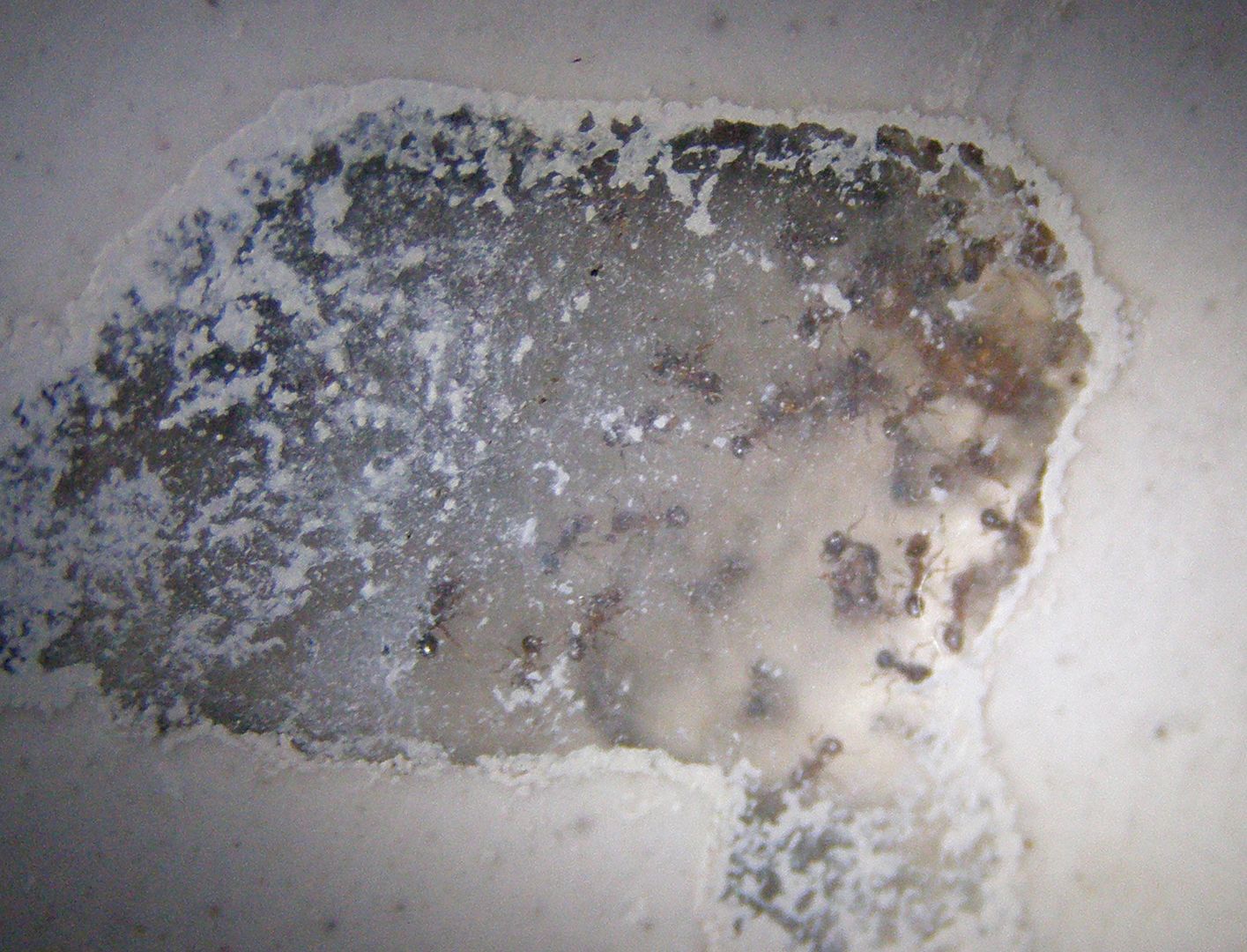
My Pheidole pilifera colony. Not that you can tell what they are though from this photo. These ants are incredibly small and normally nest in sand. This is the whole colony and they could all easily fit on the tip of my thumb. They're not digging into the plaster but are able to nibble at it. They do this mostly as a reaction to water, or in this case condensation that sometimes forms on the side. They probably won't dig tunnels into the plaster until they've expanded into the other chambers. That's a long ways off though.

They're in the middle chamber to the far right. The Test Tube is no longer in there of course, this is an old pic from the summer. I keep the surface area clean as best as I can. Black patches of mold grow if food is left there. It scrapes off easily though. I don't think I'm damaging the plaster at all. I'm really surprised that that's the only place where mold is growing. The whole setup is basically a sponge and only the parts with open access to air are really growing. Plaster setups really only last 2 years anyhow and it will be easy enough to move the colony.
Sunday, November 22, 2009
Camponotus castaneus (journal)

Both colonies are still alive and to my surprise none of the workers have died yet. They're not in the most photo friendly setup and I haven't really been trying either. Both colonies have fair sized piles of brood too, comprised of probably all 2ed or 3rd instar larva. The winter brood, laid in August or September, develops much slower then past broods, sometimes stopping all together. This is to help remove stress on the colony to forage over the winter time. To many hungry larva and the ants will simply start eating them.
The room they're currently in is among the coldest in our hour. My hands are freezing just typing this and it's supposidly 56F outside. Lighting the fireplace down in the living room doesn't help much and hopefully my colonies do well because of it. I feed them a cricket once a week or whenever I see workers foraging. They don't so much forage as, I'll see a worker standing around in the foraging area.
I've wintered colonies in our refrigerator before but supposidly it's to dry an environment. This is okay for some ants as winter time usually doesn't offer any humidity at all. Certainly nothing far above 20% or 30%. They should still have access to humidity though to be safe. I've seen other people who remove Camponotus colonies and assume their queen didn't survive. The workers all wake up but the queen remains motionless and apparently dead. In actuality Camponotus queens tend actually go into a deeper hibernation and it may take some 2 or 4 more weeks of warm temperatures to bring her out of it. Filtering may help speed this up, a process I developed where the expired ant is placed on a damp tissue or towel and left there for some time. I normally use it to revive drown ants or those who've "died" from to much carbon-dioxide poisoning, usually from rotting insects in a closed space.
The other option with hibernating colonies is a cold basement or garage. The issue here is the ants need to be kept in above freezing temps. So they need to be in a well insulated container that still offers ventilation. They need ventilation because condensation can kill the ants. The other issue is mold. Basements with musky odors and especially ones that feel damp are teaming with mold spores. This is a sign that the basement itself has poor ventilation and isn't ideal for keeping a colony.
A Food Forest
I haven't given up on the idea of a food forest just yet. But from what I've seen the lower layers need the loving hands of a garden designer. The full sun layer especially is mimicking a prairie. Prairies look nice in mass planting but vegetables and herbs don't have a real appeal here.
Here is an example I feel of a Food Forest designed well.
Here is an example I feel of a Food Forest designed well.
Saturday, November 21, 2009
Prenolepis imparis still working

Prenolepis imparis workers (The Winter Ant) foraging along a shady flower bed. The one is carrying something I can't identify though.

It's either sap from the nearby pine tree or elaiosome from the violet seeds growing in the garden bed.
Whatever the case, P. imparis is just about the only ant we're going to see on cool days. They can forage in temperatures just above freezing out which is more then a lot of other species can say.
This ant is so recognizable that I was able to make it out in The Green House's latest episode on Beekeeping. Knowing that this is one of those ants small enough and in love with sugar enough that they regularly feed on beehive feeders helped with the ID too. You can occasionally make the ants out walking along the side of his hive. It's also a neat video, enjoy!
Liatris Going to Seed
One of the most commonly sold native plants is a species of Liatris. Actually I'm not sure if it's native at all or what species it is exactly. Considering where it's coming from though I wouldn't be surprised if it were imported though. I'm talking about the Liatris sold as corms along side bagged bulbs of Crocuses, Tulips, Daffodils, Hyacinths and so on. All of those pretty fall plantings that look "so pretty" in the spring. The Liatris they sell blooms in May or June, which is odd because most other Liatris seem to bloom much much later in the year.

In the fall (ignoring the cat for a moment!) you can see it here in the lower left, glowing in the sunshine. It's seeds cover the plant in a puffy display. I always plant these in groups when I can get them because they grow so well together, and they're sold in groups of 35 or 40. Unlike the bulbs they're sold with they're actually great plants for getting pollinators too but that's not the focus here.

This was the first year that I mixed it up a bit and bought a different species of Liatris. This time I ordered from Prairie Nursery which has a good selection of Liatris. Most of them died though because my soil isn't right for them. The one variety that did great was Meadow Blazing Star, Liatris ligulistylis. And true to the photo Prairie Nursery shows it did great with the Monarchs as I covered in a previous blog post.
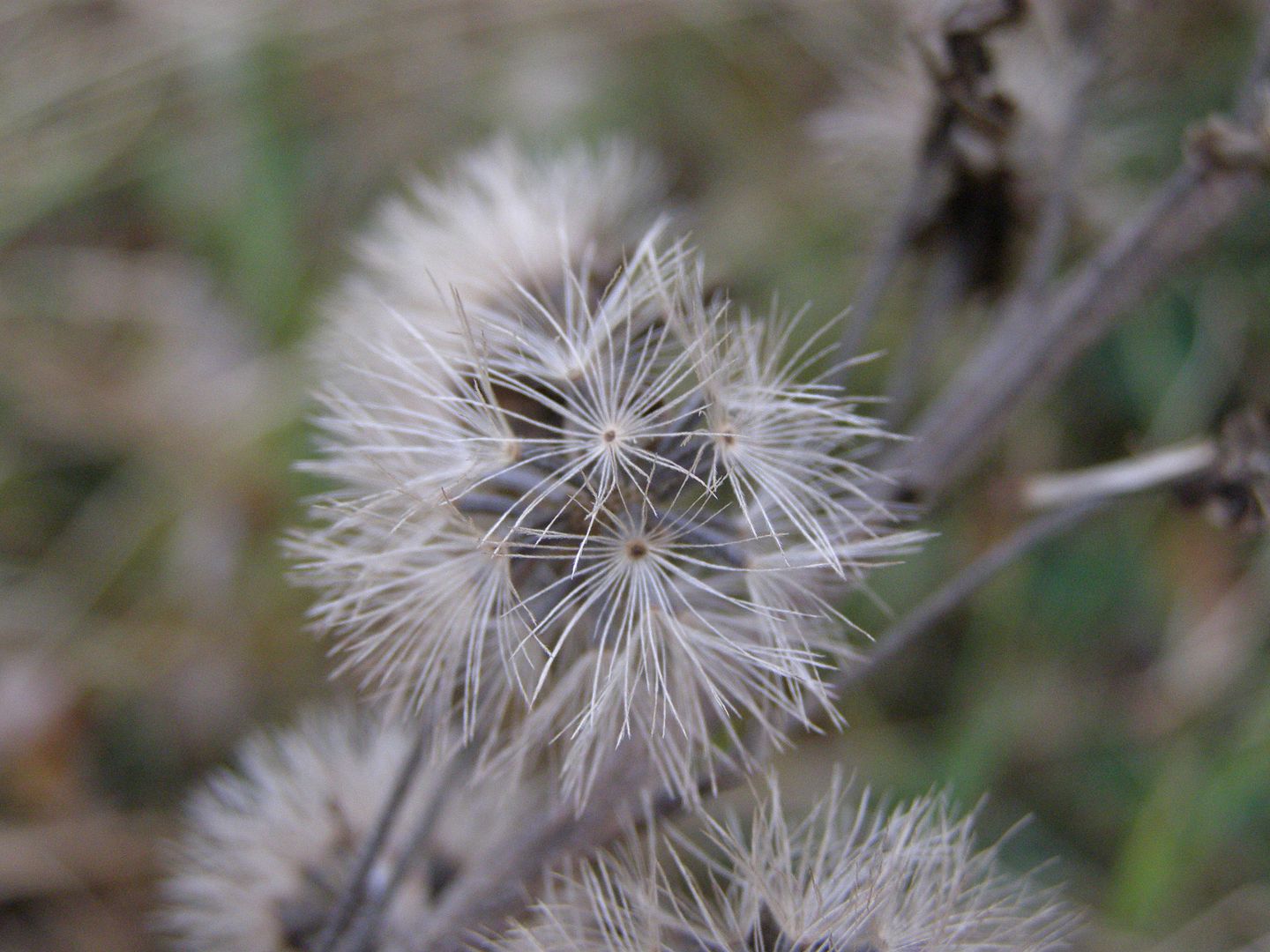
The puffy seed clusters of the Meadow Liatris are a welcome change to that of the other variety I've planted so much of. If I had more of these to play around with I might work some flower arrangement and collect the seeds for next year. I'm still collecting seeds of course but I'm also leaving a great deal of them out in the garden.

Though not the number 1 gold finch food in my opinion (#1 being sunflowers) they still eat the seeds. I haven't seen a goldfinch since August though but something clearly likes them. I've noticed Liatris grow upward developing flowers as they go, but what's odd is the first one to open up and bloom was the newest flower bud produced all the way at the top of the plant. To add to this, that also seems to be how the birds are eating the seeds, working their way down the plant.
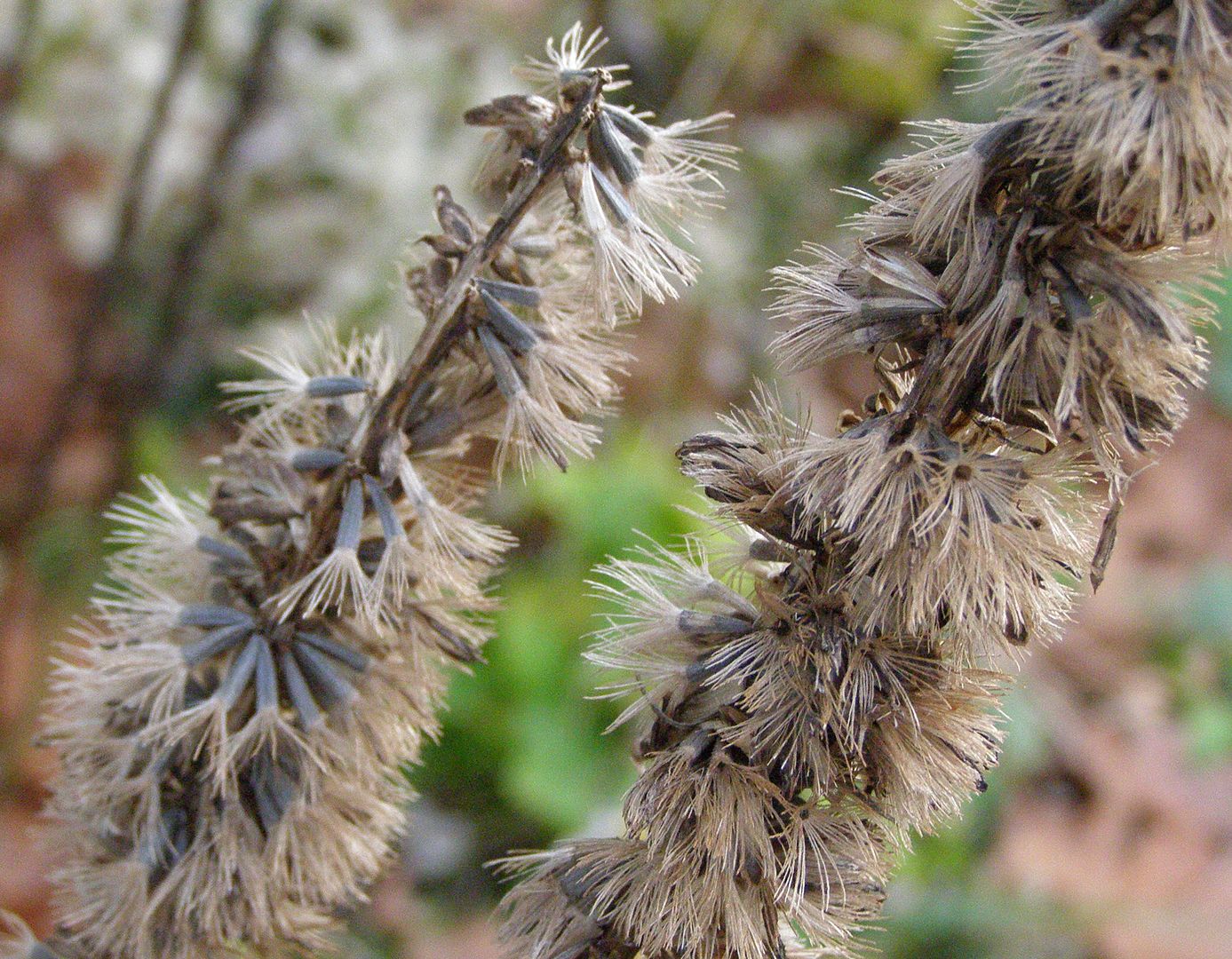
Despite the seeds to both varieties having a tough of hair on the end I don't think they fly like Dandelion seeds do. At least if they do it's not as commonly seen. Otherwise my yard would have quite the flurry of these blowing around. I really think birds are the main way of distributing these seeds. The hairs probably grab onto the seeds being eaten by the bird and get pulled off as well.

It's such a smart design too. While other plants are being covered in snow these will stay erect with only the top or maybe the side of the plant hidden. The rest of the seeds are fairly well exposed. Hopefully it will snow and I'll be able to photograph this in action.

In the fall (ignoring the cat for a moment!) you can see it here in the lower left, glowing in the sunshine. It's seeds cover the plant in a puffy display. I always plant these in groups when I can get them because they grow so well together, and they're sold in groups of 35 or 40. Unlike the bulbs they're sold with they're actually great plants for getting pollinators too but that's not the focus here.

This was the first year that I mixed it up a bit and bought a different species of Liatris. This time I ordered from Prairie Nursery which has a good selection of Liatris. Most of them died though because my soil isn't right for them. The one variety that did great was Meadow Blazing Star, Liatris ligulistylis. And true to the photo Prairie Nursery shows it did great with the Monarchs as I covered in a previous blog post.

The puffy seed clusters of the Meadow Liatris are a welcome change to that of the other variety I've planted so much of. If I had more of these to play around with I might work some flower arrangement and collect the seeds for next year. I'm still collecting seeds of course but I'm also leaving a great deal of them out in the garden.

Though not the number 1 gold finch food in my opinion (#1 being sunflowers) they still eat the seeds. I haven't seen a goldfinch since August though but something clearly likes them. I've noticed Liatris grow upward developing flowers as they go, but what's odd is the first one to open up and bloom was the newest flower bud produced all the way at the top of the plant. To add to this, that also seems to be how the birds are eating the seeds, working their way down the plant.

Despite the seeds to both varieties having a tough of hair on the end I don't think they fly like Dandelion seeds do. At least if they do it's not as commonly seen. Otherwise my yard would have quite the flurry of these blowing around. I really think birds are the main way of distributing these seeds. The hairs probably grab onto the seeds being eaten by the bird and get pulled off as well.

It's such a smart design too. While other plants are being covered in snow these will stay erect with only the top or maybe the side of the plant hidden. The rest of the seeds are fairly well exposed. Hopefully it will snow and I'll be able to photograph this in action.
Friday, November 20, 2009
Gaia's Garden (Book Review, It Sucked)
In all honesty I tried very hard to read this book, in fact I'll very likely be returning to read chapters here and there. But I feel I've read enough that I can voice an opinion. The book is
Gaia's Garden, Second Edition: A Guide To Home-Scale Permaculture
I would love to recommend this book but I just can't. It's so highly overrated on Amazon, and brings up mixed feelings in me. The book is about Food Forests and Permaculture, that is growing the most bang for your buck. The problem is the author suggests using to many nonnative plants that are the cause of current environmental problems. It's a healthier environment to have a forest but we're already landscaping homes with nonnatives as it is.
It's an easy read but reminds me to much of a text book. Each chapter starts with a few good paragraphs of useful information usually fallowed by more boring details that drive yet another nail into the coffin. Some people may like this attention to detail so that's not really a fault. I always appreciate having a book around that acts as a reference I've already read books that explained it simpler and in funner ways.
He's somehow managed to make grdening a very boring subject. Picture for a moment your garden putting out 100% efficiency. There is no lawn to speak of. There are pathways laid out in a diagonal 10 by 10 grid. Each 10 by 10 square of soil has it's own hill with a fruit tree growing on it. Around each fruit tree are an assortment of bushes, herbs, and food crops. In other words the most boring garden ever created. You and Colonel Klink (possibly the name of your dog) will tour the garden every morning at exactly Oh Nine Hundred, clipboard in one hand, garden trowel in the other for the morning inspection. Trees will be pruned, Herbs will be picked, and Sour Grapes will not be tolerated.That is exactly the image this book gives me (without any of the humor).
The problem is a lot of it goes hand and hand and what few images there are in the book usually undermine the paragraphs they go with. For example near the start of this book there are pictures of garden layouts. Picture 1 has a plants in rows with measurements how much wasted space one needs to walk between them. Picture 2 has all the plant rows close together which uses much less space. And Picture 3 shows the garden arranged in a circle with a key hole shaped pathway in the middle and all the rest is plants. Next to these wonderful pictures we have paragraphs about how to save space. Sure it's a smart design but he goes on and on and on with it. A garden of mostly key hole shaped walkways. Who honestly grows 40 herbs, for the purpose of being used as an herb? On and on with the herbs, he can't suggest enough of them. Follow this man's advice and your yard will be supplying India with herbs.
I would have loved this book if he'd just kept it garden designs and kept his plant suggestions to simple plants. In a disappointing way, though, he starts talking about the roles different types of plants play. The different categories of trees, bushes, and mentions some plants attract pollinators, or feed wildlife, or fix nitrogen in the soil. That would have been great had he just left it there, but Oh dear he goes on to start recommend plants. He mentions what a wonderful fence Bamboo will make, how great Perennial Sunflowers are, why Blueberries are fantastic plants. It's great that he named the positives but that's all he mentions! Not once does he mention Blueberry needs acidic soil in order to flower, how Perennial Sunflowers fall over and shade out the plants next to them, or how god awful Bamboo is! Nothing eats bamboo besides Panda! There are varieties of Bamboo that don't spread as violently but you won't find them mentioned in this book. People if you're going to plant bamboo... please please make sure it's completely dead , or that you live in Asia and have a stock of cuddly Pandas or try NOT PLANTING IT. If my neighbors tried planting bamboo along the fence I'd set their garden on fire.
His thoughts on attracting pollinators are sometimes laughably bad but he has a few good suggestions. One recommendation is planting Lilacs to attract bees but he doesn't mention Lilacs are notorious for not blooming sometimes for 8 years or more. He is correct though when they do bloom they do get lots of bees, the trouble is they usually bloom with fruit trees and can be viewed as competition. If you have to many things flowering besides your crops you're not getting enough bees then. He mentions what type of beneficial insects his suggestions attract and it is a nice list. Some plants like Yarrow attract tiny hover flies, and I can attest to that. They're excellent aphid control. But he doesn't really talk about seasons though, or times of blooms. Some herbs and crops he's recommending actually do a fantastic job of attracting pollinators on their own. Radishes, Chives, Onions, Fruit Trees, Melons as well as a number of herbs, Lavender and Mint especially, all do a great job of attracting pollinators! Having some Bee Balm around won't necessarily increase your crop yields. Try planting a much bigger crop to get their attention.
Only mentioning the benefits of plants is a real problem in this book. In the back there's a list of plants where Common Milkweed is listed as edible but what isn't written there is Milkweeds all contain toxins that will cause you to die after suffering from a heart attack. This stuff WILL KILL YOU, YOU WILL BE DEAD unless you boil it until it no longer tastes bitter. Even then I'm not eating it. To omit it's preparation when it's life threatening is just unforgivable. He may as well have listed Fox Glove, Digitalis, as a heart medication. This plant will kill before you've put your cup of tea down if you eat any part of it. Just because a heart medication is made from it though doesn't meant it should simply be listed as such.
As I read more and more about Forest Farming and Permaculture I'd hoped to find something to respark the magical feeling of nature in me. But sadly this book did not achieve it. Forest Farms are easily made with modern varieties of dwarf and semi-dwarf trees. There are YouTube videos that summaries the highlights of this book. It's not hard at all. I really wanted to look into this concept and love it, but I've found nothing but disappointment. It just doesn't compare with walking through a forest of native plants and watching nature do what it does best.
To summaries the concepts, plant a native tree that gets 60 feet tall. Throw in some evergreens while you're at it. In front of them plant as many 30 foot or smaller fruit trees as you can. Assorted fruits are best with multiple varieties of each. Feel free to use grafted 2 in 1 or 5 in 1 (etc...) fruit trees if you like. Below them add bush and thatch crops like Blueberry, Raspberry and so on. Below and around those throw in your annual crops in raised beds and rotate these as needed. If you like grapes or some sort of vine substitute a fruit tree for an arbor. If you live in a small space prune the fruit trees back to small bushes. Follow planting instructions as needed for each plant. That's it.... There's nothing more to it.
In the end you'll be left with a more sustainable property of almost completely alien plants. And I think that's wrong. It's like planting a lie. You have a forest that's better then having nothing at all but for nature it's still not that much better then having just a lawn. Just because a plant is useful doesn't mean you should let it bribe you into keeping it. But somehow that's fine because it's providing for you. But you've gone through all this effort, taken years of your life to plant a forest, including so many nonnative plants is almost like stepping backwards.
It's almost like he wrote a book for the wrong country. Brilliant native plants such as Trilliums have no place in this kind of garden besides being used as toilet paper. His garden designs are for efficiency and lack any concept to them.
Here is another blog that features the only real highlights found in his book. I would only recommend reading this book for that information. As it's already found online though I don't see any need to recommend buying it. He recommends way to many plants without really talking about any of them.
Gaia's Garden, Second Edition: A Guide To Home-Scale Permaculture
by Toby Hemenway
I would love to recommend this book but I just can't. It's so highly overrated on Amazon, and brings up mixed feelings in me. The book is about Food Forests and Permaculture, that is growing the most bang for your buck. The problem is the author suggests using to many nonnative plants that are the cause of current environmental problems. It's a healthier environment to have a forest but we're already landscaping homes with nonnatives as it is.
It's an easy read but reminds me to much of a text book. Each chapter starts with a few good paragraphs of useful information usually fallowed by more boring details that drive yet another nail into the coffin. Some people may like this attention to detail so that's not really a fault. I always appreciate having a book around that acts as a reference I've already read books that explained it simpler and in funner ways.
He's somehow managed to make grdening a very boring subject. Picture for a moment your garden putting out 100% efficiency. There is no lawn to speak of. There are pathways laid out in a diagonal 10 by 10 grid. Each 10 by 10 square of soil has it's own hill with a fruit tree growing on it. Around each fruit tree are an assortment of bushes, herbs, and food crops. In other words the most boring garden ever created. You and Colonel Klink (possibly the name of your dog) will tour the garden every morning at exactly Oh Nine Hundred, clipboard in one hand, garden trowel in the other for the morning inspection. Trees will be pruned, Herbs will be picked, and Sour Grapes will not be tolerated.That is exactly the image this book gives me (without any of the humor).
The problem is a lot of it goes hand and hand and what few images there are in the book usually undermine the paragraphs they go with. For example near the start of this book there are pictures of garden layouts. Picture 1 has a plants in rows with measurements how much wasted space one needs to walk between them. Picture 2 has all the plant rows close together which uses much less space. And Picture 3 shows the garden arranged in a circle with a key hole shaped pathway in the middle and all the rest is plants. Next to these wonderful pictures we have paragraphs about how to save space. Sure it's a smart design but he goes on and on and on with it. A garden of mostly key hole shaped walkways. Who honestly grows 40 herbs, for the purpose of being used as an herb? On and on with the herbs, he can't suggest enough of them. Follow this man's advice and your yard will be supplying India with herbs.
I would have loved this book if he'd just kept it garden designs and kept his plant suggestions to simple plants. In a disappointing way, though, he starts talking about the roles different types of plants play. The different categories of trees, bushes, and mentions some plants attract pollinators, or feed wildlife, or fix nitrogen in the soil. That would have been great had he just left it there, but Oh dear he goes on to start recommend plants. He mentions what a wonderful fence Bamboo will make, how great Perennial Sunflowers are, why Blueberries are fantastic plants. It's great that he named the positives but that's all he mentions! Not once does he mention Blueberry needs acidic soil in order to flower, how Perennial Sunflowers fall over and shade out the plants next to them, or how god awful Bamboo is! Nothing eats bamboo besides Panda! There are varieties of Bamboo that don't spread as violently but you won't find them mentioned in this book. People if you're going to plant bamboo... please please make sure it's completely dead , or that you live in Asia and have a stock of cuddly Pandas or try NOT PLANTING IT. If my neighbors tried planting bamboo along the fence I'd set their garden on fire.
His thoughts on attracting pollinators are sometimes laughably bad but he has a few good suggestions. One recommendation is planting Lilacs to attract bees but he doesn't mention Lilacs are notorious for not blooming sometimes for 8 years or more. He is correct though when they do bloom they do get lots of bees, the trouble is they usually bloom with fruit trees and can be viewed as competition. If you have to many things flowering besides your crops you're not getting enough bees then. He mentions what type of beneficial insects his suggestions attract and it is a nice list. Some plants like Yarrow attract tiny hover flies, and I can attest to that. They're excellent aphid control. But he doesn't really talk about seasons though, or times of blooms. Some herbs and crops he's recommending actually do a fantastic job of attracting pollinators on their own. Radishes, Chives, Onions, Fruit Trees, Melons as well as a number of herbs, Lavender and Mint especially, all do a great job of attracting pollinators! Having some Bee Balm around won't necessarily increase your crop yields. Try planting a much bigger crop to get their attention.
Only mentioning the benefits of plants is a real problem in this book. In the back there's a list of plants where Common Milkweed is listed as edible but what isn't written there is Milkweeds all contain toxins that will cause you to die after suffering from a heart attack. This stuff WILL KILL YOU, YOU WILL BE DEAD unless you boil it until it no longer tastes bitter. Even then I'm not eating it. To omit it's preparation when it's life threatening is just unforgivable. He may as well have listed Fox Glove, Digitalis, as a heart medication. This plant will kill before you've put your cup of tea down if you eat any part of it. Just because a heart medication is made from it though doesn't meant it should simply be listed as such.
As I read more and more about Forest Farming and Permaculture I'd hoped to find something to respark the magical feeling of nature in me. But sadly this book did not achieve it. Forest Farms are easily made with modern varieties of dwarf and semi-dwarf trees. There are YouTube videos that summaries the highlights of this book. It's not hard at all. I really wanted to look into this concept and love it, but I've found nothing but disappointment. It just doesn't compare with walking through a forest of native plants and watching nature do what it does best.
To summaries the concepts, plant a native tree that gets 60 feet tall. Throw in some evergreens while you're at it. In front of them plant as many 30 foot or smaller fruit trees as you can. Assorted fruits are best with multiple varieties of each. Feel free to use grafted 2 in 1 or 5 in 1 (etc...) fruit trees if you like. Below them add bush and thatch crops like Blueberry, Raspberry and so on. Below and around those throw in your annual crops in raised beds and rotate these as needed. If you like grapes or some sort of vine substitute a fruit tree for an arbor. If you live in a small space prune the fruit trees back to small bushes. Follow planting instructions as needed for each plant. That's it.... There's nothing more to it.
In the end you'll be left with a more sustainable property of almost completely alien plants. And I think that's wrong. It's like planting a lie. You have a forest that's better then having nothing at all but for nature it's still not that much better then having just a lawn. Just because a plant is useful doesn't mean you should let it bribe you into keeping it. But somehow that's fine because it's providing for you. But you've gone through all this effort, taken years of your life to plant a forest, including so many nonnative plants is almost like stepping backwards.
It's almost like he wrote a book for the wrong country. Brilliant native plants such as Trilliums have no place in this kind of garden besides being used as toilet paper. His garden designs are for efficiency and lack any concept to them.
Here is another blog that features the only real highlights found in his book. I would only recommend reading this book for that information. As it's already found online though I don't see any need to recommend buying it. He recommends way to many plants without really talking about any of them.
Overwintering Caterpillars
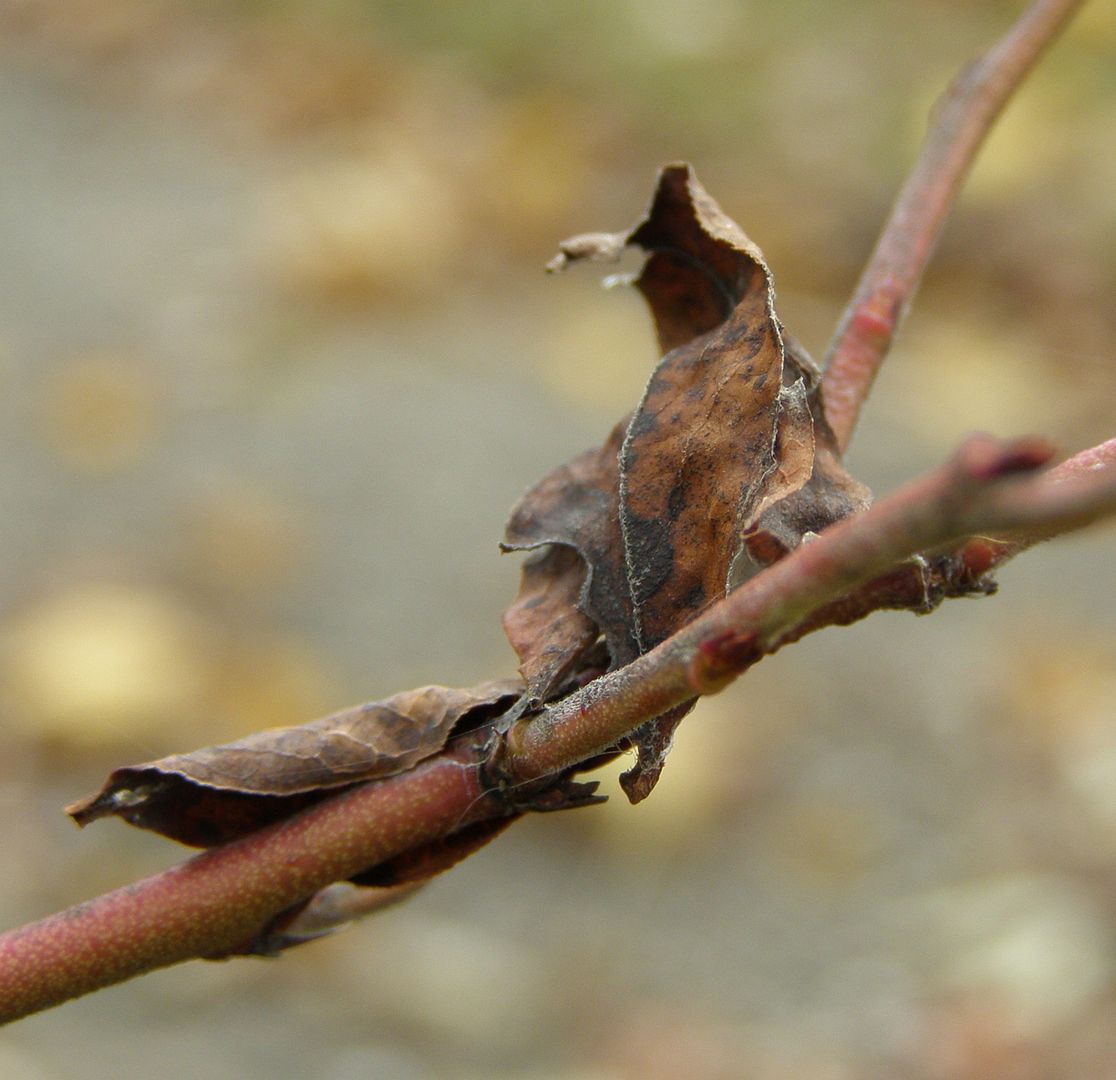
Seeds are one thing to find in winter but caterpillars are quite another. Even though they're still developing it's still possible to find them. I doubt they're worth eating at this time though. On our blueberry bushes all of the leaves have fallen off ... with the exception of these two or three.
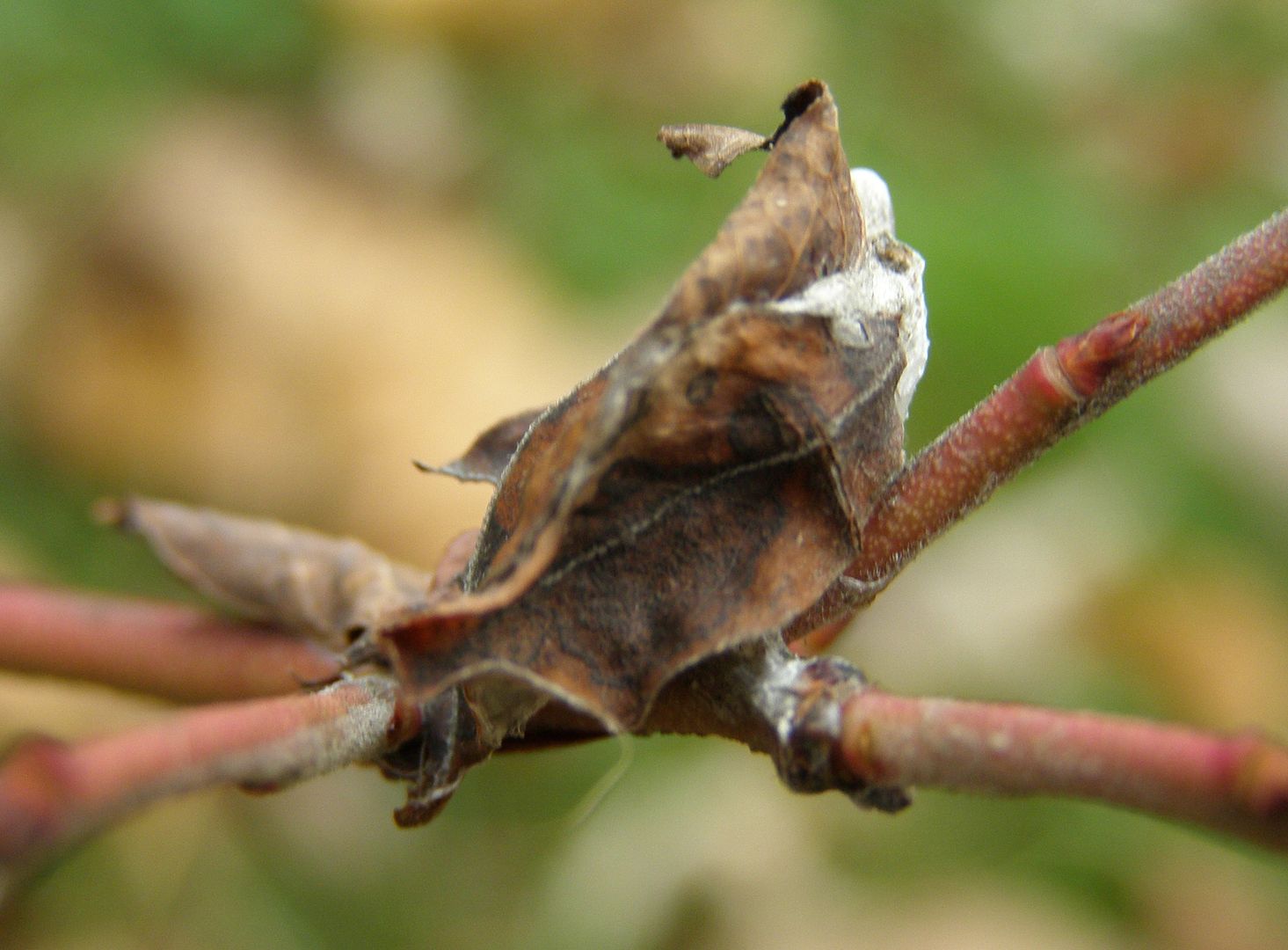
From another angle the silk is more easily seen. Within this cluster of leaves is a caterpillar of some overwintering species. Mostly likely a moth of some kind. They'll remain attached to the plant until the spring time when it will hatch and start the cycle all over again.
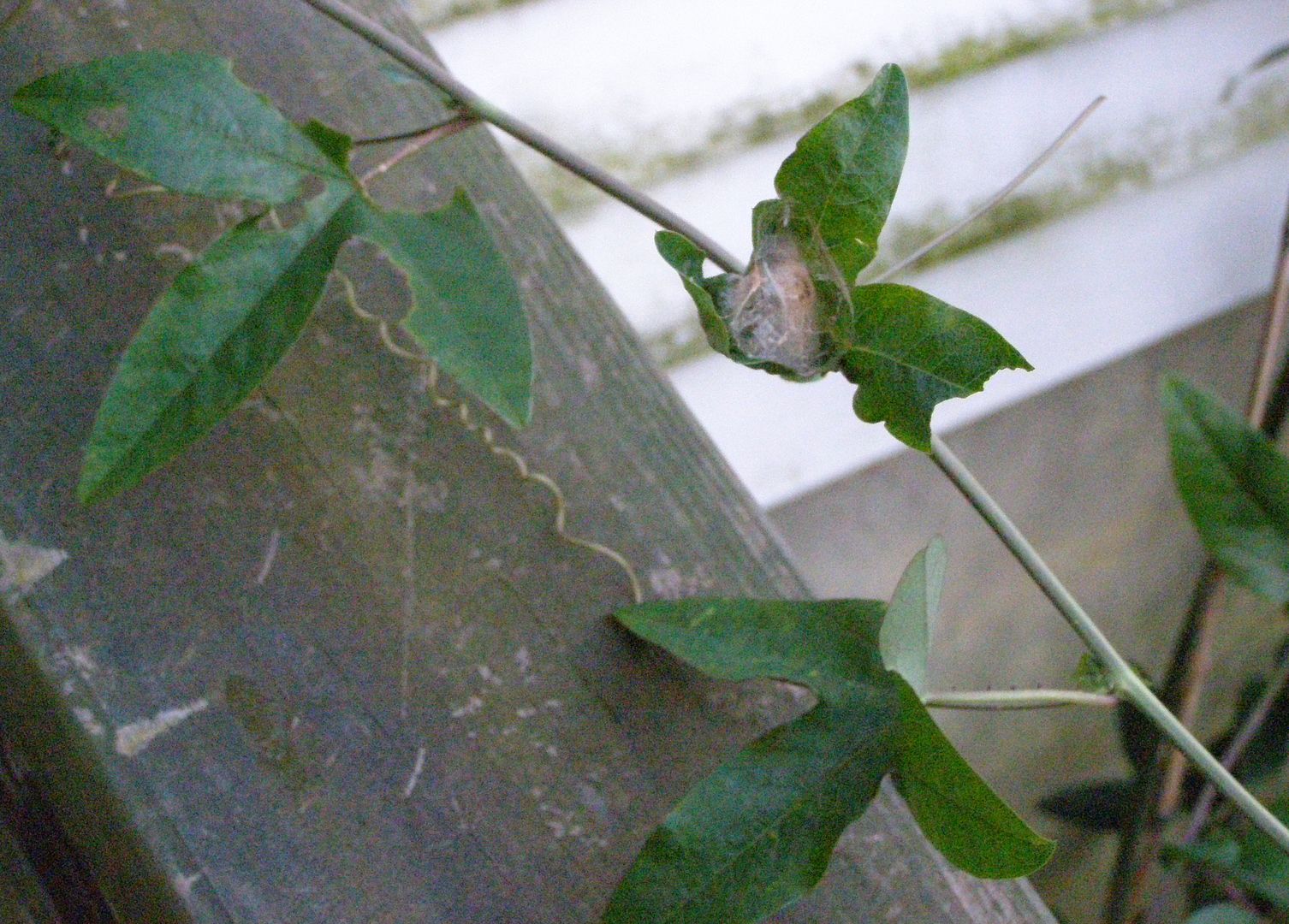
Our Passion Fruit Vine also houses a caterpillar. Passiflora incarnata is surprisingly native considering how exotic looking it's flower is. This is the first year I've had this plant and it hasn't flowered yet. So for flower pictures I turn to Google Search. The fruit is supposidly edible too. However I'm told this is considered a noxious weed. Not only does it spread by seed but it sends up suckers up to 15 feet from the parent plant. Thankfully I'm at the norther most part of this plant's range so hopefully it will play nice.
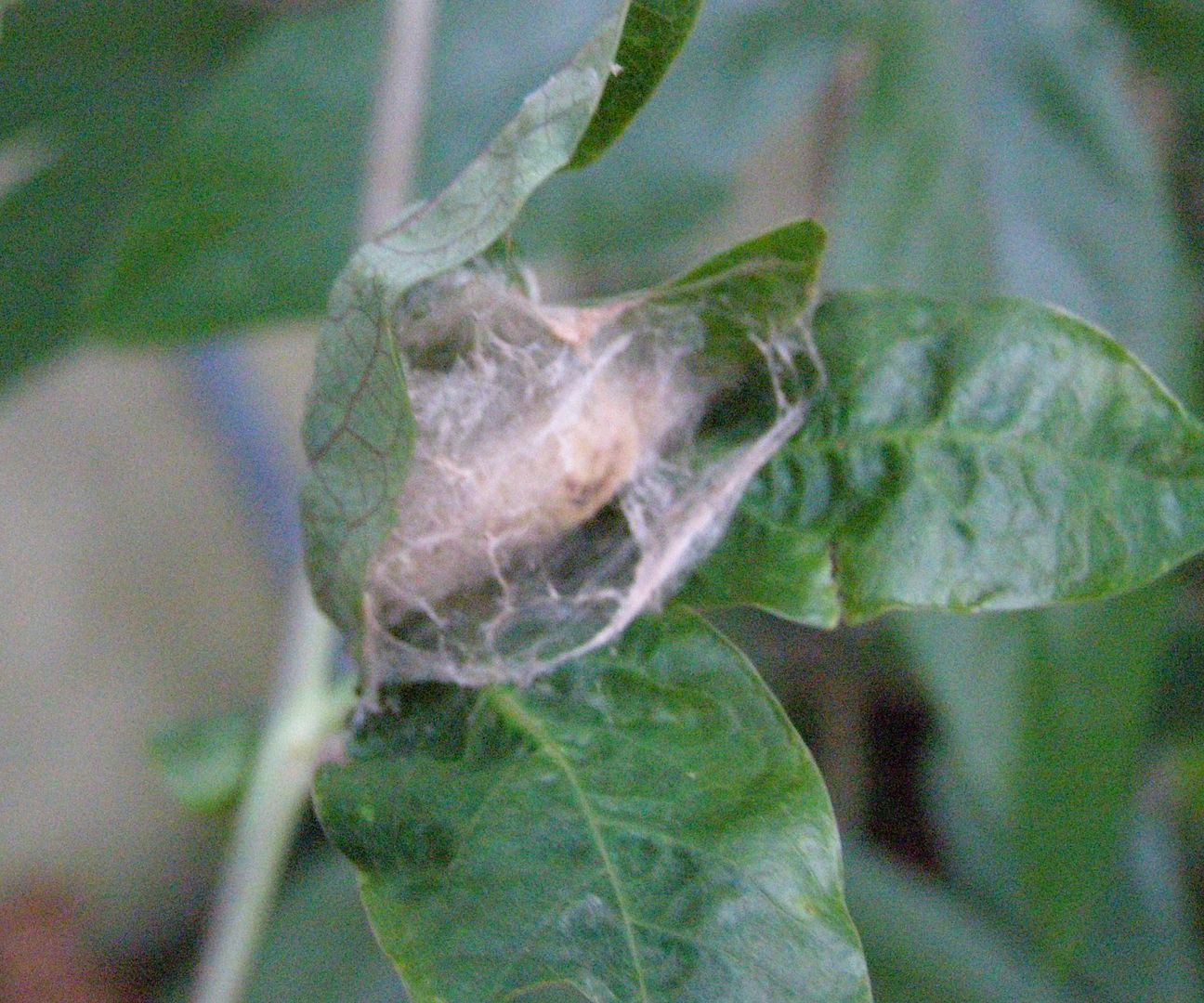
Considering how pretty the butterflies are it might be worth having such a plant around. Agraulis species are among the prettiest North America has to offer. The only other butterflys that have the intense orange colors I can really think of are all Milkweed Butterflies like the Monarch. Here's hoping for some bright colors next spring.
Labels:
Caterpillar,
Cocoons,
Winter
Thursday, November 19, 2009
Green Porno?
First an odd sort of warning. This isn't as "dirty" as the word Porno leads you to believe but at the same time it's probably Not Work Safe! It's hilarious all the same.
Let actress Isabella Rossellini teach you about sex and the environment! Here is the Green Porno website.
Let actress Isabella Rossellini teach you about sex and the environment! Here is the Green Porno website.
Aster novae-angliae fall color

The brilliant fall colors aren't just up in the trees or down in the bushes. Aster novae-angliae is a New England aster that looks like it was tie-dyed.
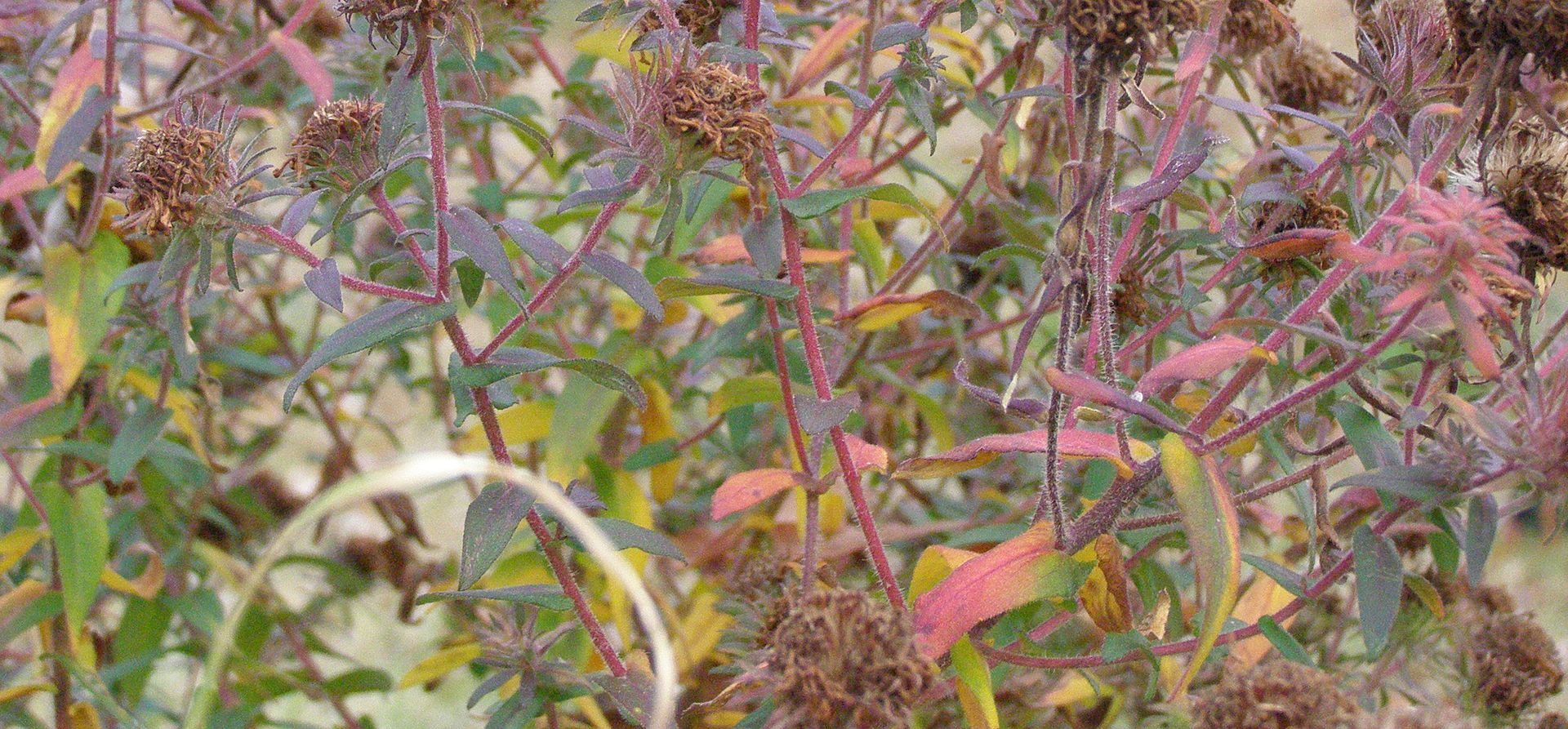
The red stems, the dark purple/brown seed heads, the multicolored leaves all look fantastic against the backdrop of our dormant lawn. It's just another reason I'm hoping this plant spreads like a weed.
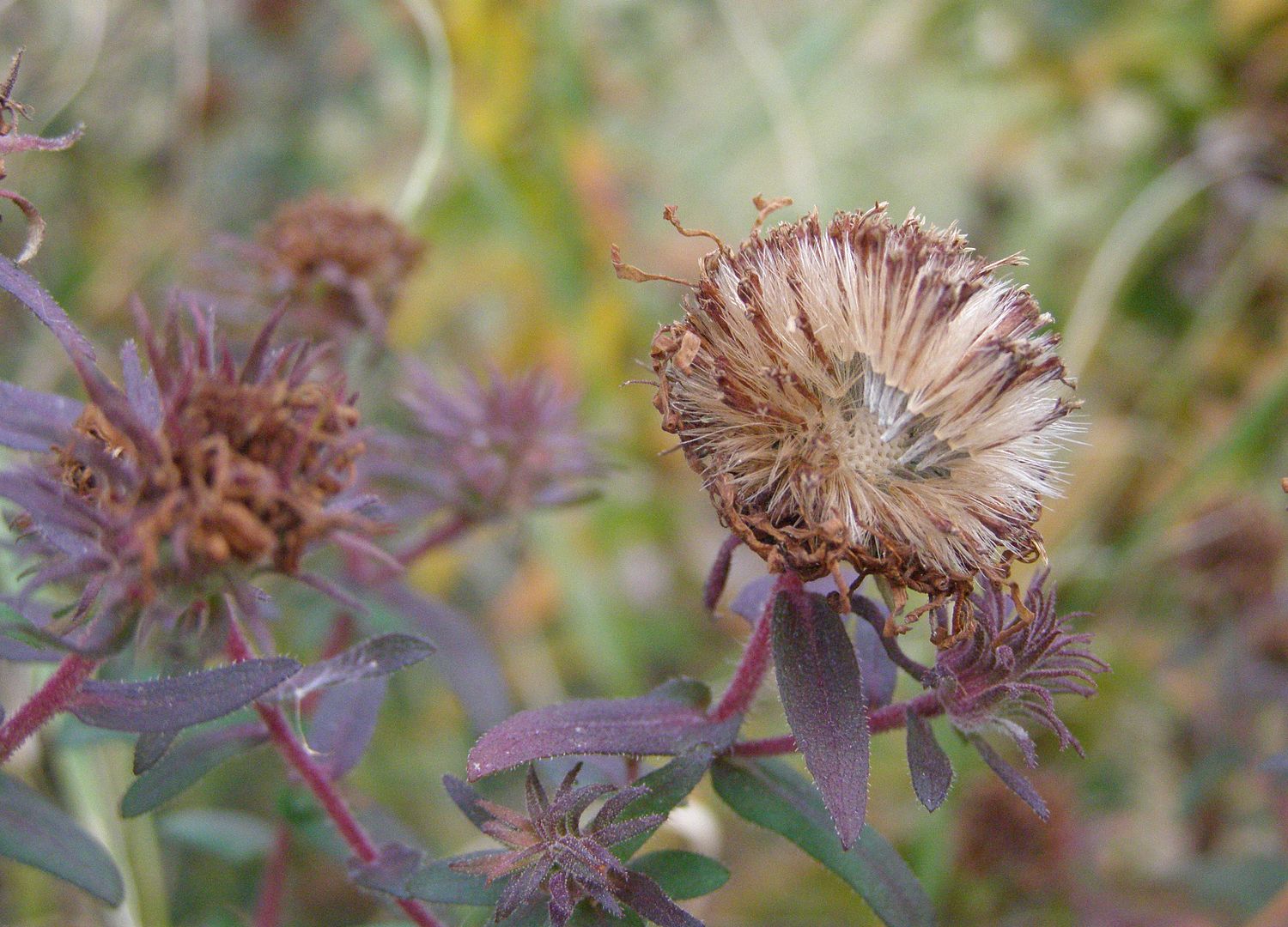
Here's another reason to not clear out the garden until next March. Colors aside, the seed heads are up off the ground where birds can easily get at them. After it snows over the winter all the lower growing plants become covered. The upper growth to herbaceous perennials keep the seeds up above the snow line and offer them up to birds. The snow melts off the top of the plants first and reveals the seeds when they're needed most.
Labels:
fall color,
Seeds
Wednesday, November 18, 2009
Joe Pye Weed Seeds
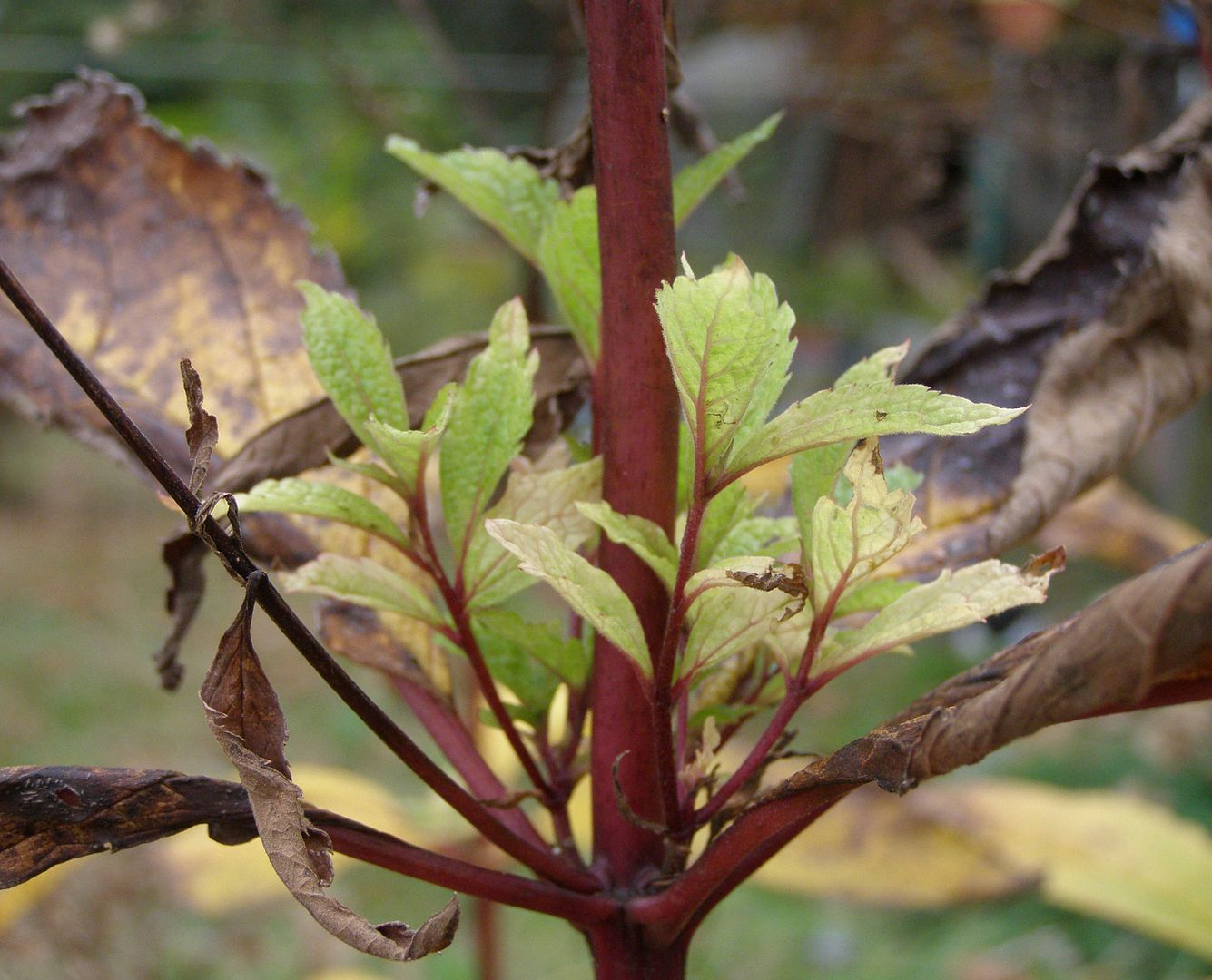
Fall forces plants to do a lot of crazy things. Pictured here is a hollow stem Joe Pye Weed, Eupatorium fistulosum. Though the main growth of the plant clearly died back it's still pushing out new growth. This picture is a few weeks old.
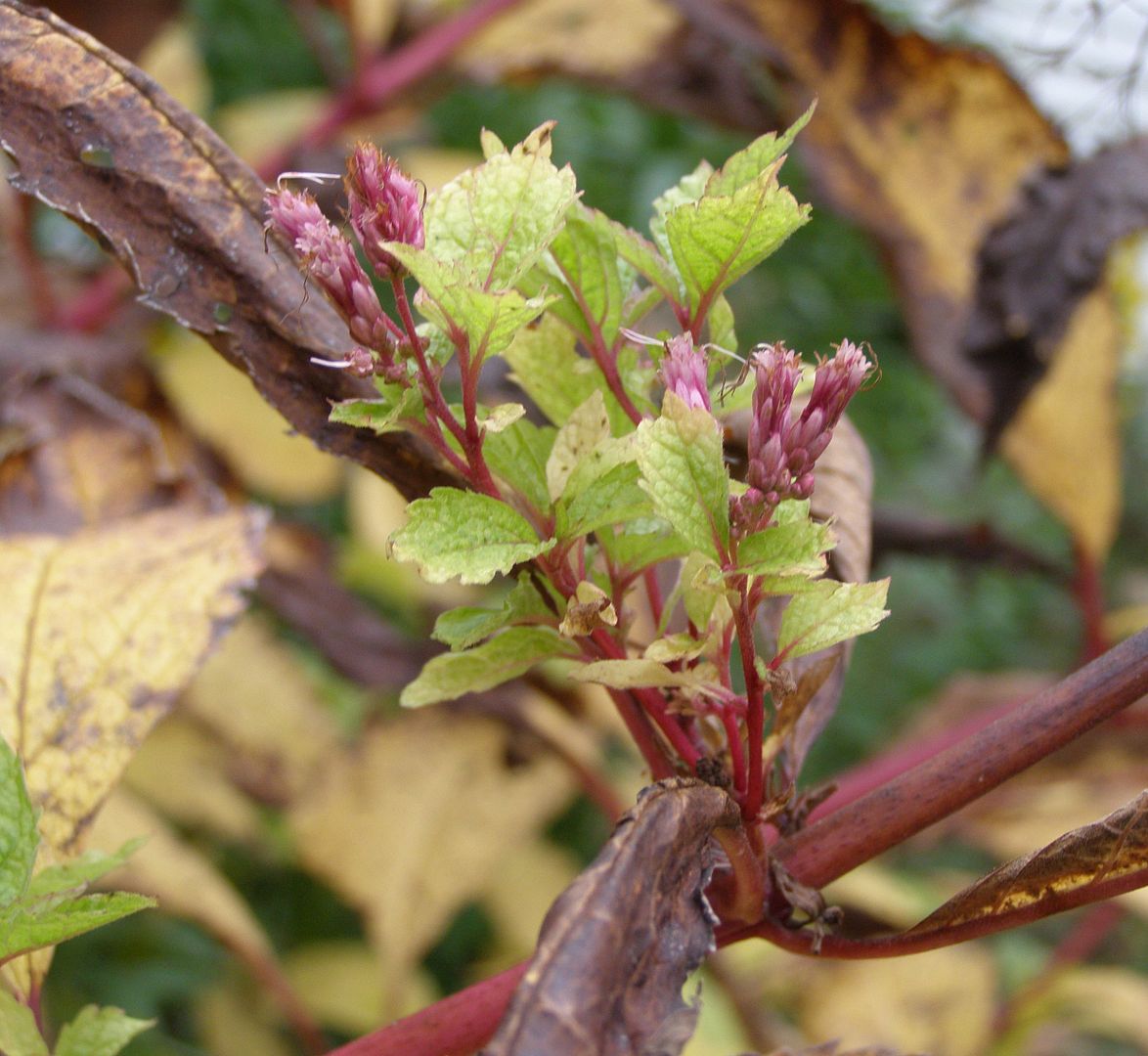
As we go more current we see this minor growth had a purpose. All over the plant there are tiny clusters of flowers, compared with the normal mats of flowers in July.

They don't get nearly as many pollinators now as they're competing with Asters and Goldenrods that bloom their best in the autumn. But a few of our native bees are happy to pollinate them all the same.
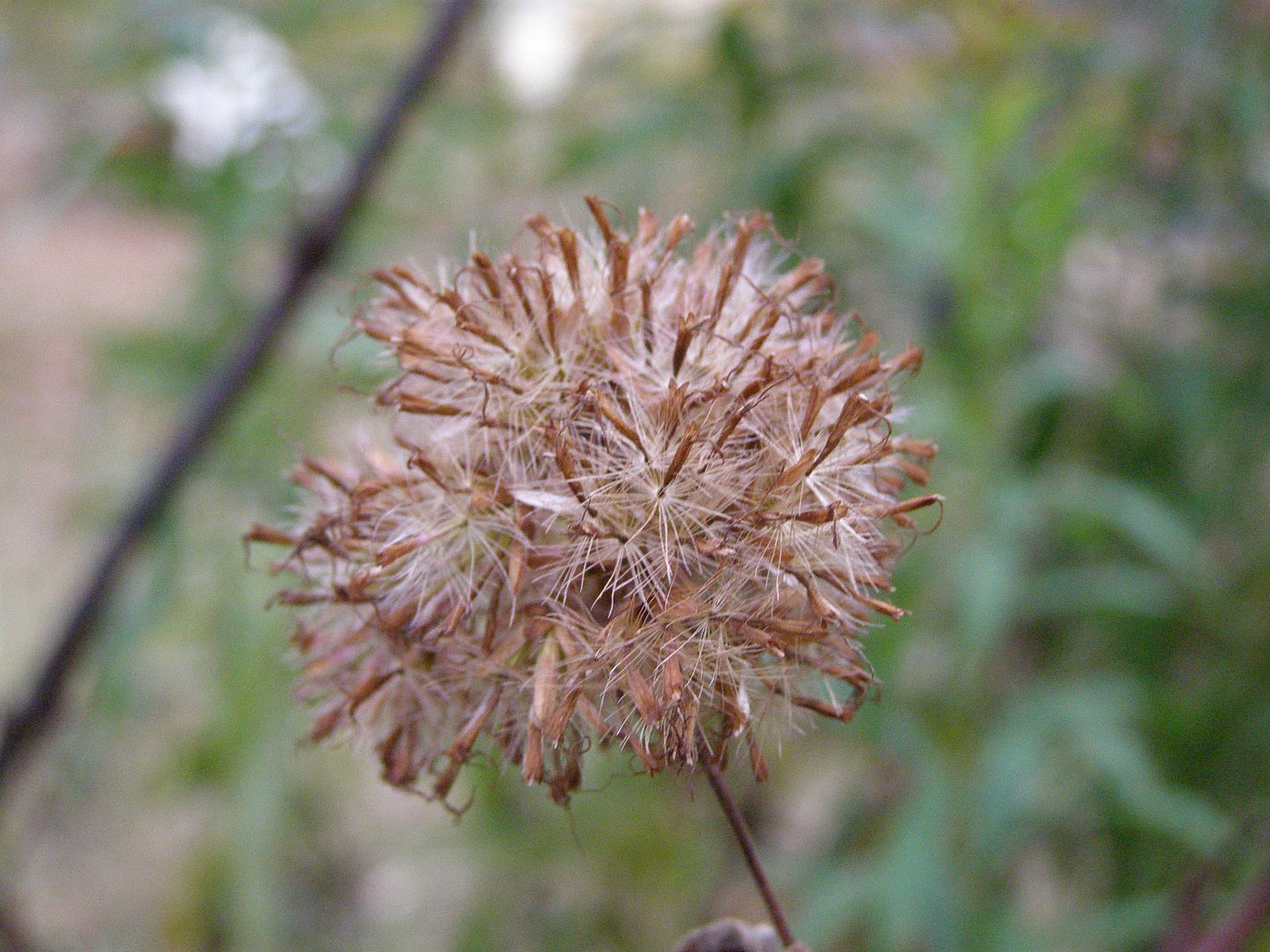
Clearly it has paid off. This picture I took only hours ago. While almost all the seeds on the plant have blown away or been eaten by birds this new cluster happens just in time for the end of fall.
Labels:
Joe Pye Weed,
Seeds
Tuesday, November 17, 2009
Nothing Special
I'll be honest I haven't done much with Ants, Bees, Butterflies, or stepped out doors to see Nature in a while.
Scraping the bottom of the barrel though, I've fed my ant colonies. I don't think I'll be hibernating them as this room gets pretty cold at night as it is.
As far as bees go, my order of mason bee tubes from Knox has arrived. My Honey Bee hives outside seem to be doing fine. On warm days they're still active anyhow, but I should probably sneak a peak inside them.
Haven't seen a Butterfly in weeks but I do have an overwintering caterpillar on our Passion Flower Vine. I'm probably living right on the norther most boundary of it's range before the plant becomes an annual though.
Nature; I've been enjoying the fall colors but they've all but vanished now. While walking the dog I see people doing the craziest things with their leaves. There is more then one home I'm sad to say that has been so brainwashed by old landscaping habits that they have setup compost bins by the street... And I don't understand these people one little bit. Their neighbors rake leaves up in a neat little piles by the curb to be picked up, they're taken by whoever does that. But these people have four steaks in the ground that holds a net so the leaves don't blow away... despite the fact that there are piles of leaves around them not going anywhere. I'm at such a loss of words. I want to yell at these people in passing and tell them to compost in the backyard. It's not like they don't already have the bin for it. I think these people grow giant pods under their bed.
Scraping the bottom of the barrel though, I've fed my ant colonies. I don't think I'll be hibernating them as this room gets pretty cold at night as it is.
As far as bees go, my order of mason bee tubes from Knox has arrived. My Honey Bee hives outside seem to be doing fine. On warm days they're still active anyhow, but I should probably sneak a peak inside them.
Haven't seen a Butterfly in weeks but I do have an overwintering caterpillar on our Passion Flower Vine. I'm probably living right on the norther most boundary of it's range before the plant becomes an annual though.
Nature; I've been enjoying the fall colors but they've all but vanished now. While walking the dog I see people doing the craziest things with their leaves. There is more then one home I'm sad to say that has been so brainwashed by old landscaping habits that they have setup compost bins by the street... And I don't understand these people one little bit. Their neighbors rake leaves up in a neat little piles by the curb to be picked up, they're taken by whoever does that. But these people have four steaks in the ground that holds a net so the leaves don't blow away... despite the fact that there are piles of leaves around them not going anywhere. I'm at such a loss of words. I want to yell at these people in passing and tell them to compost in the backyard. It's not like they don't already have the bin for it. I think these people grow giant pods under their bed.
Saturday, November 14, 2009
Chicken Coop Anyone?
This seems like a nice compact way of raising chickens.
Now if only it wasn't five hundred dollars. I'm sure it could be built for much less but it's a neat design to keep in mind when designing a coop.
We used to have a rooster back when my dad did Animal Control. Actually we had two but they were on separate occasions. They're a lot bigger then I was expecting and they actually did the rooster cry in the early morning hours. But it lacked the alarm clock quality I came to expect. (Our neighbors may have had a different experience though.) Maybe he was just defective.
Our cats were fascinated at first by the giant bird. I recall our youngest cat at the time actually jumping on top of the bird and biting down. This may have been effective had the cat actually managed to get onto of the bird or gone for it's neck. As it was though the juvenile kitten was only a fourth the bird's size. The Rooster quickly beat poor Buddy to the ground squawking ensued as the he was chased out of the yard. Buddy stopped after crawling under the fence thinking he was safe. The Rooster flew up onto our fence and continued the chase into the front yard.
We found him moments later clawing at the front door to get in. The Rooster slowly came into view down the driveway with his beak in a threatening hiss-like pose.
We kept the Rooster for a few weeks until my dad found a suitable home for it. A farm or animal shelter I imagen. A lot of the shelters here seem to have collections of odd animals. Peacocks, and Horses are at the bottom of the list. Exotic Snakes, Chinchillas, and Alligators are more commonly encountered then you would expect. Coming home to find a baby Alligator in our bathtub was another thrill but uneventful.
We had a Turkey once too. I don't know how but I believe it needed to be rescued or removed from someone's home or something like that. So my dad brought it home and put it in our dog kennel/cage. It's was a 12 by 9 area with a doghouse in it, of fenced in area with no roof. Having never had a turkey before we didn't realize it could simply fly out. Despite dragging a gowned of tail feathers behind it they can fly incredible distances.
My dad and I were doing things outside when we realized the bird was now on top of the doghouse. "How did he jump that high?" I recall one of us saying. We went back to doing whatever and next I recall hearing a tree branch loudly rustling from the Willow Oak right above the cage. "Where did the bird go?" I recall saying.
The turkey, now having enough elevation to take flew from the trees and over our neighbors privacy fence. It's wings flapped now flapping, my dad and I watched in awe as the bird started gliding two blocks over before finally crashing into the dark thatch of a 60 foot tall evergreen. It's branches shook as if massive gale of wind had struck the tree.
I ran to the person's house while my dad got into his Animal Control Vehicular. He needed to load up some things quickly so I arrived at the house first. "Uhh there is a Turkey in your tree." I said laughing at how stupid it sounded. The owner rolled his eyes (I think) and closed the door. I don't think he believed me. Having told him though, I went right into his backyard. The tree was somewhat unique so my dad had no trouble finding the place. He showed up with a ladder and a control pole. The Owner of the house eventually came outside when he saw my dad prodding his tree. The Turkey within, clumsily bumbled it's way down and went quietly after that.
We used to have a rooster back when my dad did Animal Control. Actually we had two but they were on separate occasions. They're a lot bigger then I was expecting and they actually did the rooster cry in the early morning hours. But it lacked the alarm clock quality I came to expect. (Our neighbors may have had a different experience though.) Maybe he was just defective.
Our cats were fascinated at first by the giant bird. I recall our youngest cat at the time actually jumping on top of the bird and biting down. This may have been effective had the cat actually managed to get onto of the bird or gone for it's neck. As it was though the juvenile kitten was only a fourth the bird's size. The Rooster quickly beat poor Buddy to the ground squawking ensued as the he was chased out of the yard. Buddy stopped after crawling under the fence thinking he was safe. The Rooster flew up onto our fence and continued the chase into the front yard.
We found him moments later clawing at the front door to get in. The Rooster slowly came into view down the driveway with his beak in a threatening hiss-like pose.
We kept the Rooster for a few weeks until my dad found a suitable home for it. A farm or animal shelter I imagen. A lot of the shelters here seem to have collections of odd animals. Peacocks, and Horses are at the bottom of the list. Exotic Snakes, Chinchillas, and Alligators are more commonly encountered then you would expect. Coming home to find a baby Alligator in our bathtub was another thrill but uneventful.
We had a Turkey once too. I don't know how but I believe it needed to be rescued or removed from someone's home or something like that. So my dad brought it home and put it in our dog kennel/cage. It's was a 12 by 9 area with a doghouse in it, of fenced in area with no roof. Having never had a turkey before we didn't realize it could simply fly out. Despite dragging a gowned of tail feathers behind it they can fly incredible distances.
My dad and I were doing things outside when we realized the bird was now on top of the doghouse. "How did he jump that high?" I recall one of us saying. We went back to doing whatever and next I recall hearing a tree branch loudly rustling from the Willow Oak right above the cage. "Where did the bird go?" I recall saying.
The turkey, now having enough elevation to take flew from the trees and over our neighbors privacy fence. It's wings flapped now flapping, my dad and I watched in awe as the bird started gliding two blocks over before finally crashing into the dark thatch of a 60 foot tall evergreen. It's branches shook as if massive gale of wind had struck the tree.
I ran to the person's house while my dad got into his Animal Control Vehicular. He needed to load up some things quickly so I arrived at the house first. "Uhh there is a Turkey in your tree." I said laughing at how stupid it sounded. The owner rolled his eyes (I think) and closed the door. I don't think he believed me. Having told him though, I went right into his backyard. The tree was somewhat unique so my dad had no trouble finding the place. He showed up with a ladder and a control pole. The Owner of the house eventually came outside when he saw my dad prodding his tree. The Turkey within, clumsily bumbled it's way down and went quietly after that.
Wednesday, November 11, 2009
Stevia
It seemed like about a year ago there was a huge controversy over the Stevia plant, Stevia rebaudiana. It's an herb I've personally grown. You can buy the extract of it but only as a "dietary supplement," and marketed as something diabetics would use. Well not really marketed, more like what is this jar on the shelf? That's why you find it in the medicine isle and not next to the bags of sugar where a sweetener should be.
Today though I'm seeing it advertised in loads of products. All sorts of teas, health foods, and just about anything you can sweeten. And it's all along side sugar. For the longest time the sugar industry has been fighting this plant and I guess they finally lost. (Also considering Stevia is a sweetener that doesn't need to be grown in harsh conditions like Sugar Cain it raises some questions about certain historic events, but I don't think Stevia was known back then. It's only recently that people realized Banana trees grow on snow covered mountains in South America and Africa.)
Supposedly it's "300 times sweeter then sugar." In all honesty I don't understand this saying at all. The Stevia I grew didn't become sweet until late summer. The leaves can be eaten off the plant directly and have a unique plant taste to them. It's not like sugar but defiantly reacts to your tongue. It's almost a tickling sensation, as if someone took fibers of celery like a paint brush and were brushing your tongue lightly.
Saying it's 300 times sweeter then sugar I don't get though. It's sweet, and actually has a bitterness to it thanks to the plant taste. If you can get rid of that you might be in business. I attempted to make "Stevia Extract" but now looking back I think all I did was make Stevia Tea. Tasted awful.
Still it's a neat plant, not native but fun to try. It's also an annual where I live too, but it's very productive. I remember paying something like $20 for 7 seeds. When they finally flowered though they produced seeds like crazy. I expect the price has probably dropped since then.
Today though I'm seeing it advertised in loads of products. All sorts of teas, health foods, and just about anything you can sweeten. And it's all along side sugar. For the longest time the sugar industry has been fighting this plant and I guess they finally lost. (Also considering Stevia is a sweetener that doesn't need to be grown in harsh conditions like Sugar Cain it raises some questions about certain historic events, but I don't think Stevia was known back then. It's only recently that people realized Banana trees grow on snow covered mountains in South America and Africa.)
Supposedly it's "300 times sweeter then sugar." In all honesty I don't understand this saying at all. The Stevia I grew didn't become sweet until late summer. The leaves can be eaten off the plant directly and have a unique plant taste to them. It's not like sugar but defiantly reacts to your tongue. It's almost a tickling sensation, as if someone took fibers of celery like a paint brush and were brushing your tongue lightly.
Saying it's 300 times sweeter then sugar I don't get though. It's sweet, and actually has a bitterness to it thanks to the plant taste. If you can get rid of that you might be in business. I attempted to make "Stevia Extract" but now looking back I think all I did was make Stevia Tea. Tasted awful.
Still it's a neat plant, not native but fun to try. It's also an annual where I live too, but it's very productive. I remember paying something like $20 for 7 seeds. When they finally flowered though they produced seeds like crazy. I expect the price has probably dropped since then.
Sunday, November 8, 2009
Defenders of Wildlife
http://www.defenders.org/
Please sign this petition and help protect the rare wolf. Sarah Palin can fly her helicopter elsewhere!
Please sign this petition and help protect the rare wolf. Sarah Palin can fly her helicopter elsewhere!
Friday, November 6, 2009
7ft ant nests get GPS addresses to stop them being destroyed
7ft Ant Nests get GPS Addresses to Stop Their Destruction
''We have pledged to restore all the ancient sites on our 80,000-hectare (200,000-acre) estate in the region and we're also offering generous grants to encourage other land managers to follow suit. Such woods are wonderful places for wildlife, including the remarkable hairy wood ant.''
This is great because it protects a real wonder of the natural world. Some of the species in the genus Formica are called Wood Ants. It's a common genus in all northern temperate zones, but the thatch mound building species are somewhat rare. These ants build mounds that act as natural compost piles and last for years. Gardeners in North America (when not mistaking them for fire ant mounds) always try and get rid of the unsightly mounds. But consider the benefits to having a true predatory force living in your yard. When gypsy moth damage is photographed there are often patches where the forest is unharmed. Guess what ants tend to be living in the unaffected area.
''We have pledged to restore all the ancient sites on our 80,000-hectare (200,000-acre) estate in the region and we're also offering generous grants to encourage other land managers to follow suit. Such woods are wonderful places for wildlife, including the remarkable hairy wood ant.''
This is great because it protects a real wonder of the natural world. Some of the species in the genus Formica are called Wood Ants. It's a common genus in all northern temperate zones, but the thatch mound building species are somewhat rare. These ants build mounds that act as natural compost piles and last for years. Gardeners in North America (when not mistaking them for fire ant mounds) always try and get rid of the unsightly mounds. But consider the benefits to having a true predatory force living in your yard. When gypsy moth damage is photographed there are often patches where the forest is unharmed. Guess what ants tend to be living in the unaffected area.
Tuesday, November 3, 2009
City Life?
I don't understand how people live in the city. I visited my Cousin's house in PA today and they have a spacious apartment/condo/home, I'm not really sure on the correct term to their home. Basically you walk into a living room with a stair way infront of you. Behind the living room is the dinning room and behind that is the kitchen. Beyond that is their "yard" which is a closed in space with a door leading back out to the street. It's more like a place to park a bike. There is not lawn, just potted plants. Most of what they're growing are trees. I had no idea people could live this way.
They could plant an herb garden but really potted plants are the limit of their growing ability.
It just makes me want to garden and work the land I have even more. I've decided next year I'll be planting another 5 fruit trees. I'm even toying with the crazy idea of making one of those a hardy banana tree. How I'm going to make a banana tree blend in with my native landscape though is going to be tricky though.
While touring the city I saw an attempt to grow some trees. Sadly they just don't work though. Their idea of growing trees is removing a tile of sidewalk and put a sapling in the ground. Most of these are dwarf sized flowering trees that no one seems to be caring for. The tree planting process seems to have failed on a lot of streets. With what few roads I went down I really though what a waste planting trees here was. People don't care about them. Out front of one home there was a stump someone was using like a cup holder.
They could plant an herb garden but really potted plants are the limit of their growing ability.
It just makes me want to garden and work the land I have even more. I've decided next year I'll be planting another 5 fruit trees. I'm even toying with the crazy idea of making one of those a hardy banana tree. How I'm going to make a banana tree blend in with my native landscape though is going to be tricky though.
While touring the city I saw an attempt to grow some trees. Sadly they just don't work though. Their idea of growing trees is removing a tile of sidewalk and put a sapling in the ground. Most of these are dwarf sized flowering trees that no one seems to be caring for. The tree planting process seems to have failed on a lot of streets. With what few roads I went down I really though what a waste planting trees here was. People don't care about them. Out front of one home there was a stump someone was using like a cup holder.
Monday, November 2, 2009
Woolly Aphids in Lasius claviger Nest
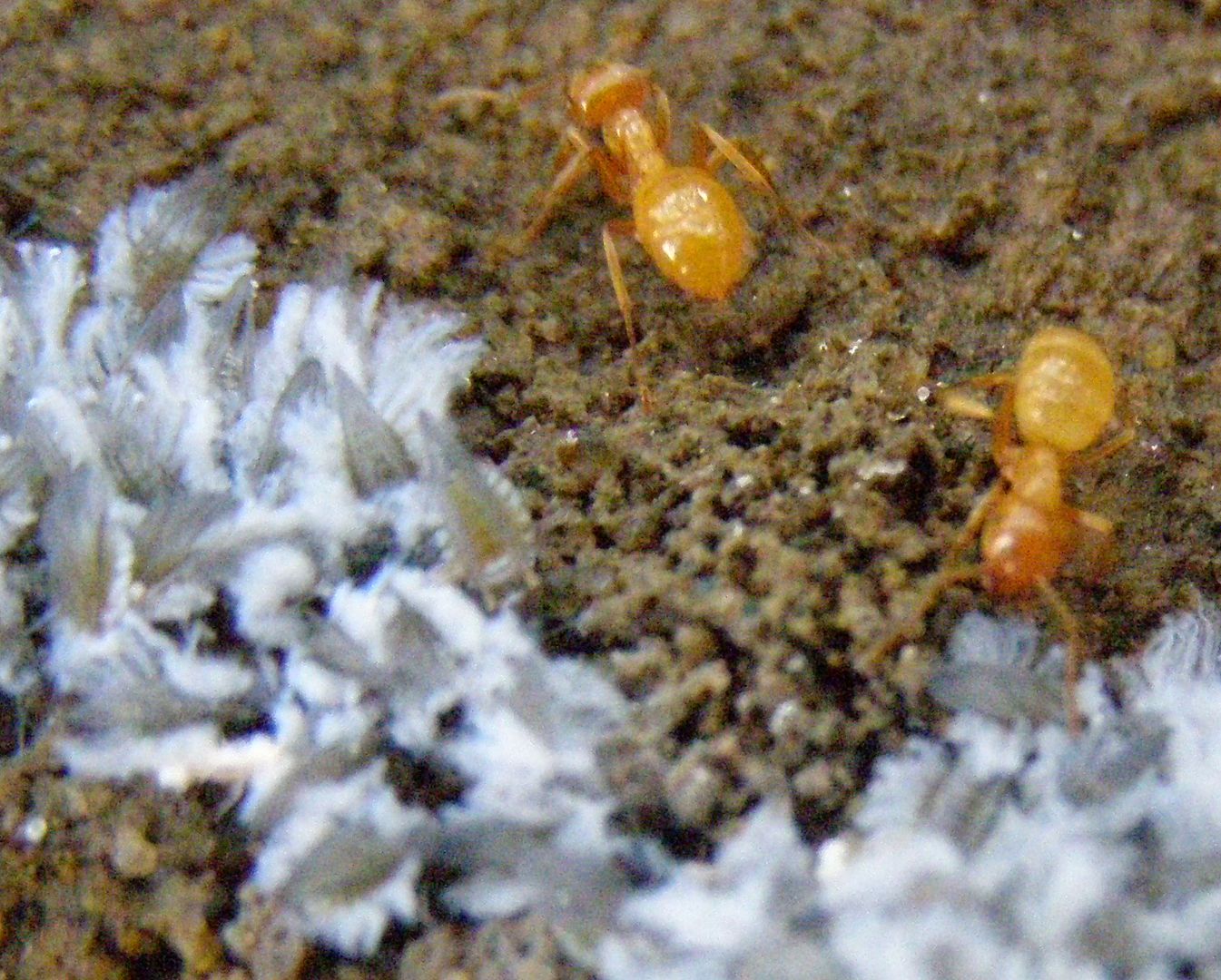
Last week I stumbled across something odd in one of the Lasius claviger colonies out in the yard. This colony nests under a large slab of stone under our Willow Oak, Quercus phellos. Woolly Aphids were in the ant colony. This is interesting for a number of reasons.
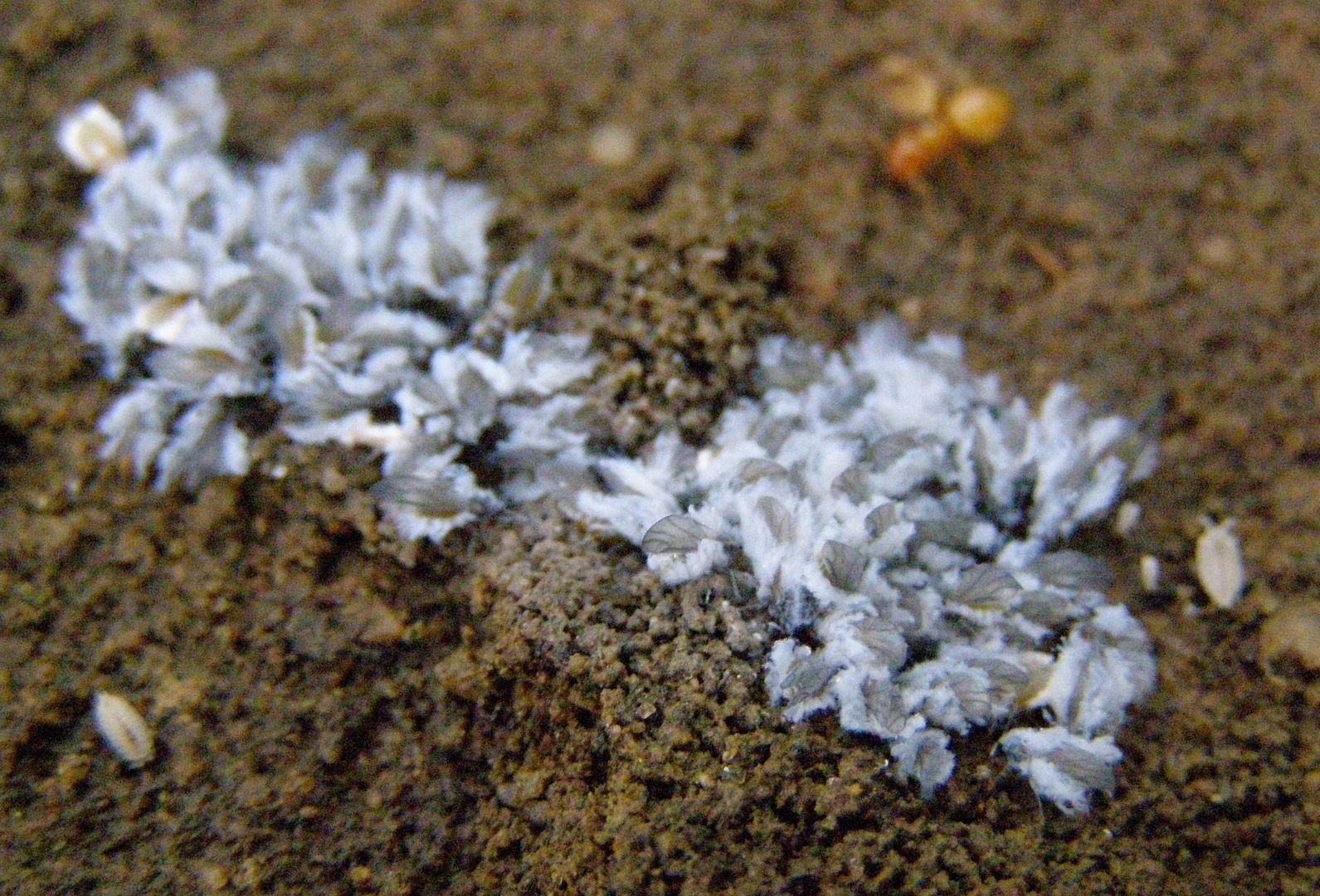
1) Lasius claviger is completely subterranean. Colonies are only open now to release queens for their autumn flights.

2) You will note all the aphids are adult reproductives, they all have wings. Normally aphids die off during the winter but their eggs survive. Some aphids though overwinter as adults and lay eggs in the spring. I'm not sure which is the case here.

3) Woolly aphids don't feed on roots! The normal aphids Lasius claviger tend to are all root aphids (seen in white above). Woolly aphids normally feed on the green growth to a wide variety of trees.
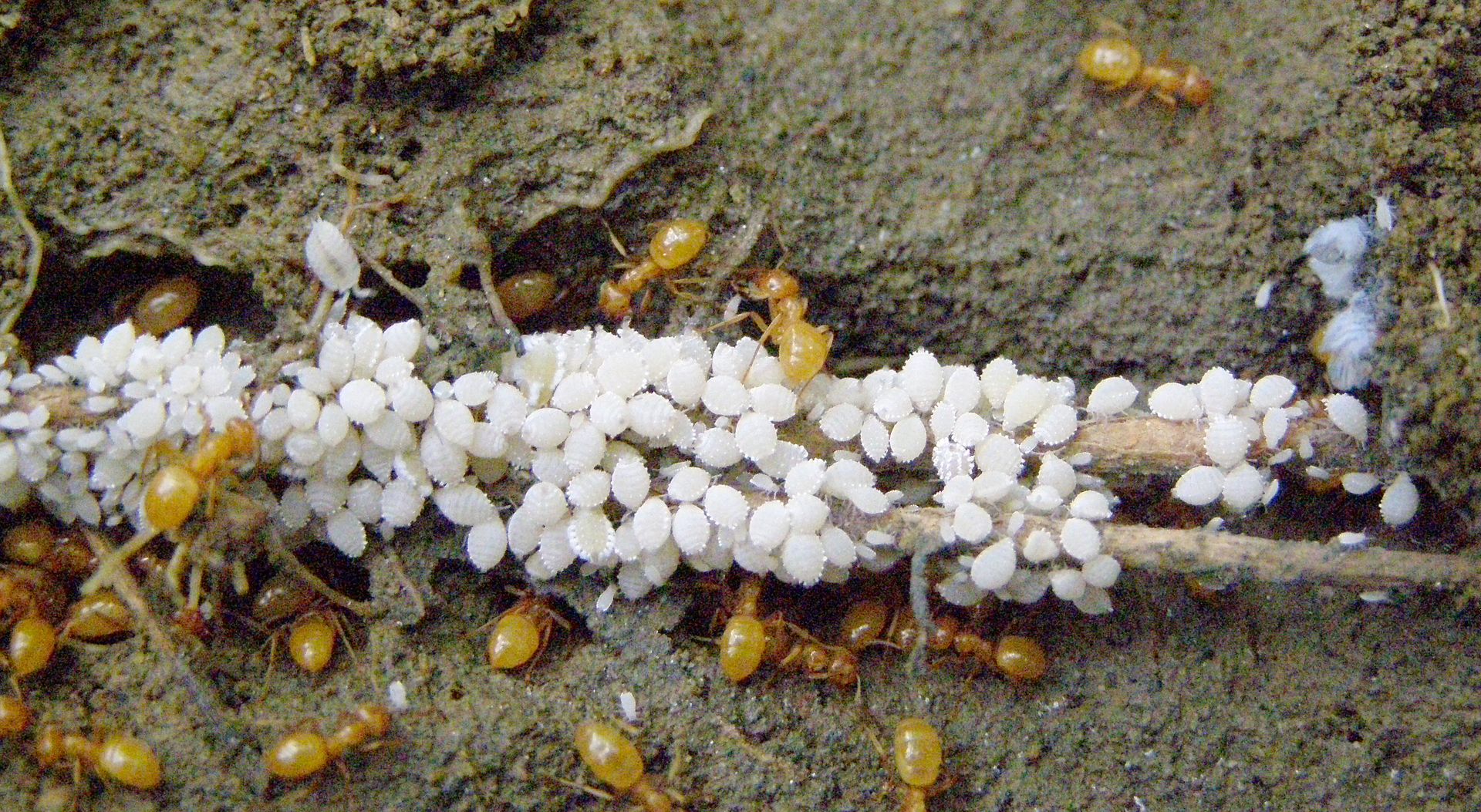
4) Though not producing any nectar they're still welcome in the ant nest. They're likely producing eggs, just as all the other aphids in the L. claviger nest are doing, to be overwinter in the ant nest. Or they're simply over wintering along with the other aphids. Honestly though I'm not sure about this. Aphids seem to be even less studied then ants are.
Knox is Back in Business!
Knox Cellars Native Pollinators is surely one of the best providers of Mason Bee tubes in the country. Their website over the summer seemed to be replaced temporarily by some tuxedo site, I suspect hacking! But I'm thrilled to see their site back up and running.
When one thinks of pollinators so frequently we are compelled to go to the Honey Bee, Apis mellifera. But the problem here is they're too social! Hives remain at a constant strength and population of 20,000 to 80,000 bees year round. This is great to get some pollination but ideally you'll get better pollination with a variety of bees that are different sizes. All it takes is something like CCD and suddenly our prized source of pollination goes kaput.
Bumblebees are another wonderful choice. The worker size varies over the time of year and life of a hive. But the problem here is their hives are annual. Meaning every winter they all die off except for new queens that have to over winter and start new hives next year. They just don't (A) live that long, and (B) store enough honey to make it thorough the winter. While they are a great pollinator, they just don't have the numbers during the spring months and on a bad year can be scarce even in early Summer. Knox does sell a "Humble Bumble Home" for them but unfortunately I've put one out for the past two years without success. (If you are in a southern state though where it remains warm you may have better luck though.)
The Answer is quite simply The Mason Bee!

These are an ideal pollinator. Though solitary they like to nest around one another. Simply putting out some tubes (like those sold at KnoxCellar.com) in sunny spot under the eve of a house and usually a few will show up. Their normal time of activity is the spring, about when blueberries and fruit trees start to bloom. These bees are more focused towards pollen which they store for the next generation. Unlike other bees that go more for the nectar.

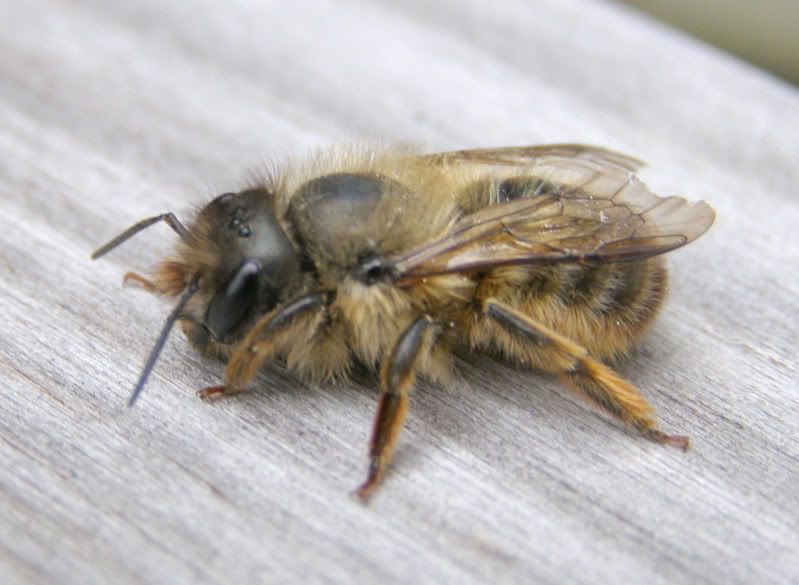
Best of all, Mason Bees are virtually sting-less. They do have a stinger of course but they lack the hive mind to use it. They're solitary females living nesting in a community with a safety in numbers strategy. There are no guard bees, no caste system beyond that of gender, and I've personally handled them.
Because they nest in tubes their populations can be monitored and protected for next year's generation. They do need some care as far as wintering goes though but it's simple enough. I haven't mastered that yet so I'll point you towards this book which I'm reading.
Pollination with Mason Bees: A Gardener and Naturalists' Guide to Managing Mason Bees for Fruit Production
I like the information in it but the images are pretty bad. Most of them are hand drawn and surely could have been better.
When one thinks of pollinators so frequently we are compelled to go to the Honey Bee, Apis mellifera. But the problem here is they're too social! Hives remain at a constant strength and population of 20,000 to 80,000 bees year round. This is great to get some pollination but ideally you'll get better pollination with a variety of bees that are different sizes. All it takes is something like CCD and suddenly our prized source of pollination goes kaput.
Bumblebees are another wonderful choice. The worker size varies over the time of year and life of a hive. But the problem here is their hives are annual. Meaning every winter they all die off except for new queens that have to over winter and start new hives next year. They just don't (A) live that long, and (B) store enough honey to make it thorough the winter. While they are a great pollinator, they just don't have the numbers during the spring months and on a bad year can be scarce even in early Summer. Knox does sell a "Humble Bumble Home" for them but unfortunately I've put one out for the past two years without success. (If you are in a southern state though where it remains warm you may have better luck though.)
The Answer is quite simply The Mason Bee!

These are an ideal pollinator. Though solitary they like to nest around one another. Simply putting out some tubes (like those sold at KnoxCellar.com) in sunny spot under the eve of a house and usually a few will show up. Their normal time of activity is the spring, about when blueberries and fruit trees start to bloom. These bees are more focused towards pollen which they store for the next generation. Unlike other bees that go more for the nectar.


Best of all, Mason Bees are virtually sting-less. They do have a stinger of course but they lack the hive mind to use it. They're solitary females living nesting in a community with a safety in numbers strategy. There are no guard bees, no caste system beyond that of gender, and I've personally handled them.
Because they nest in tubes their populations can be monitored and protected for next year's generation. They do need some care as far as wintering goes though but it's simple enough. I haven't mastered that yet so I'll point you towards this book which I'm reading.
Pollination with Mason Bees: A Gardener and Naturalists' Guide to Managing Mason Bees for Fruit Production
I like the information in it but the images are pretty bad. Most of them are hand drawn and surely could have been better.
Sunday, November 1, 2009
Subscribe to:
Posts (Atom)
